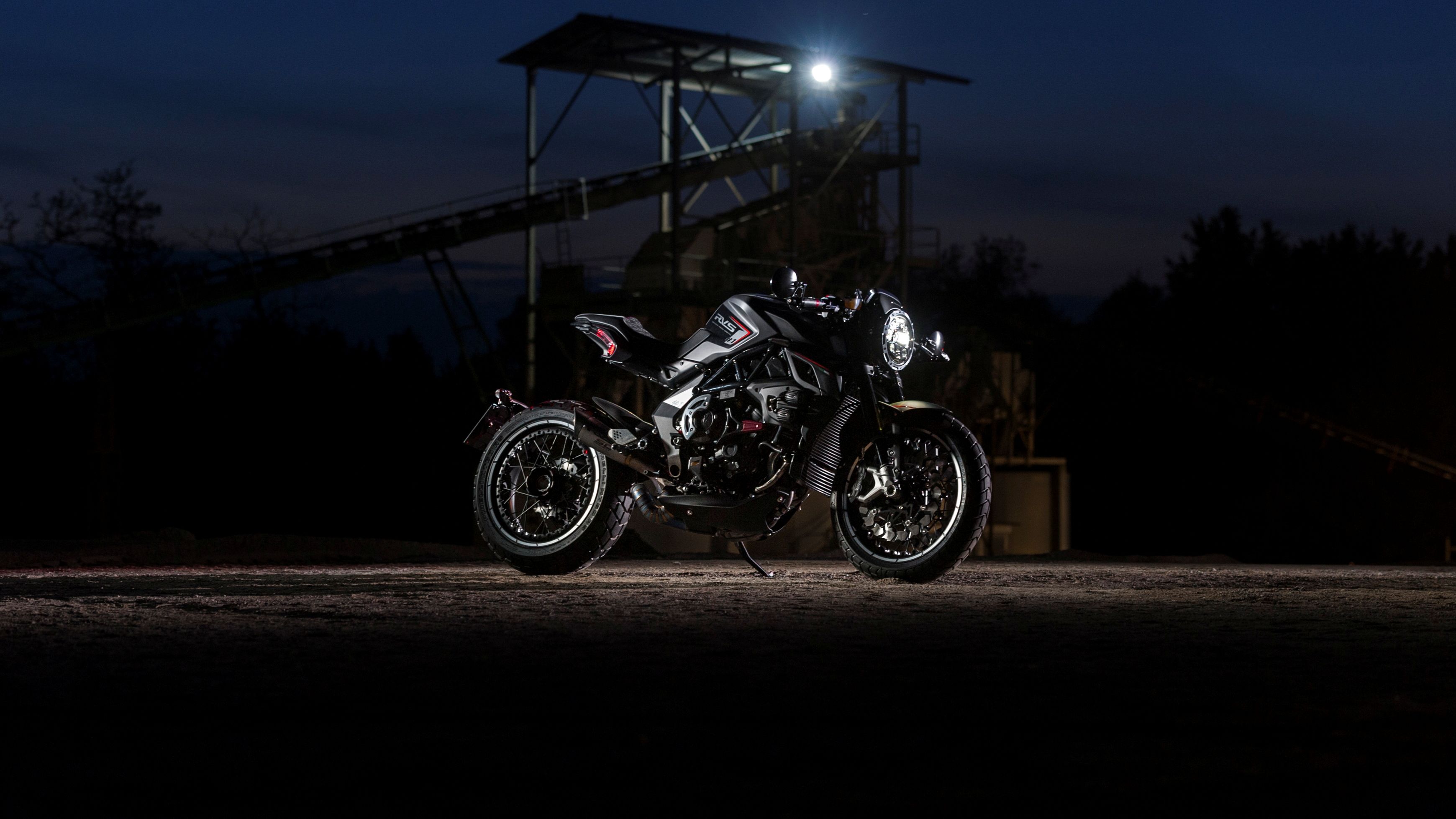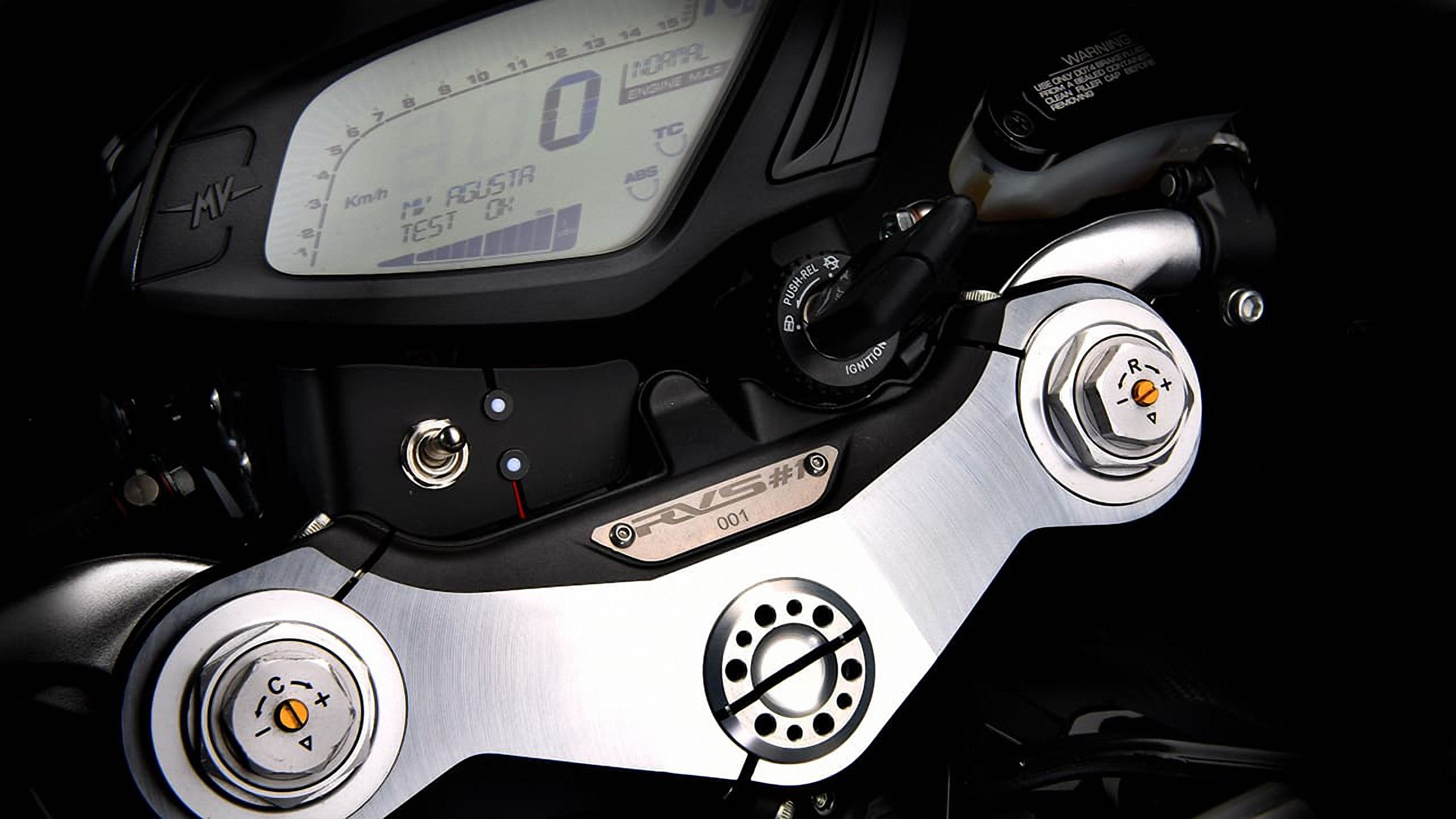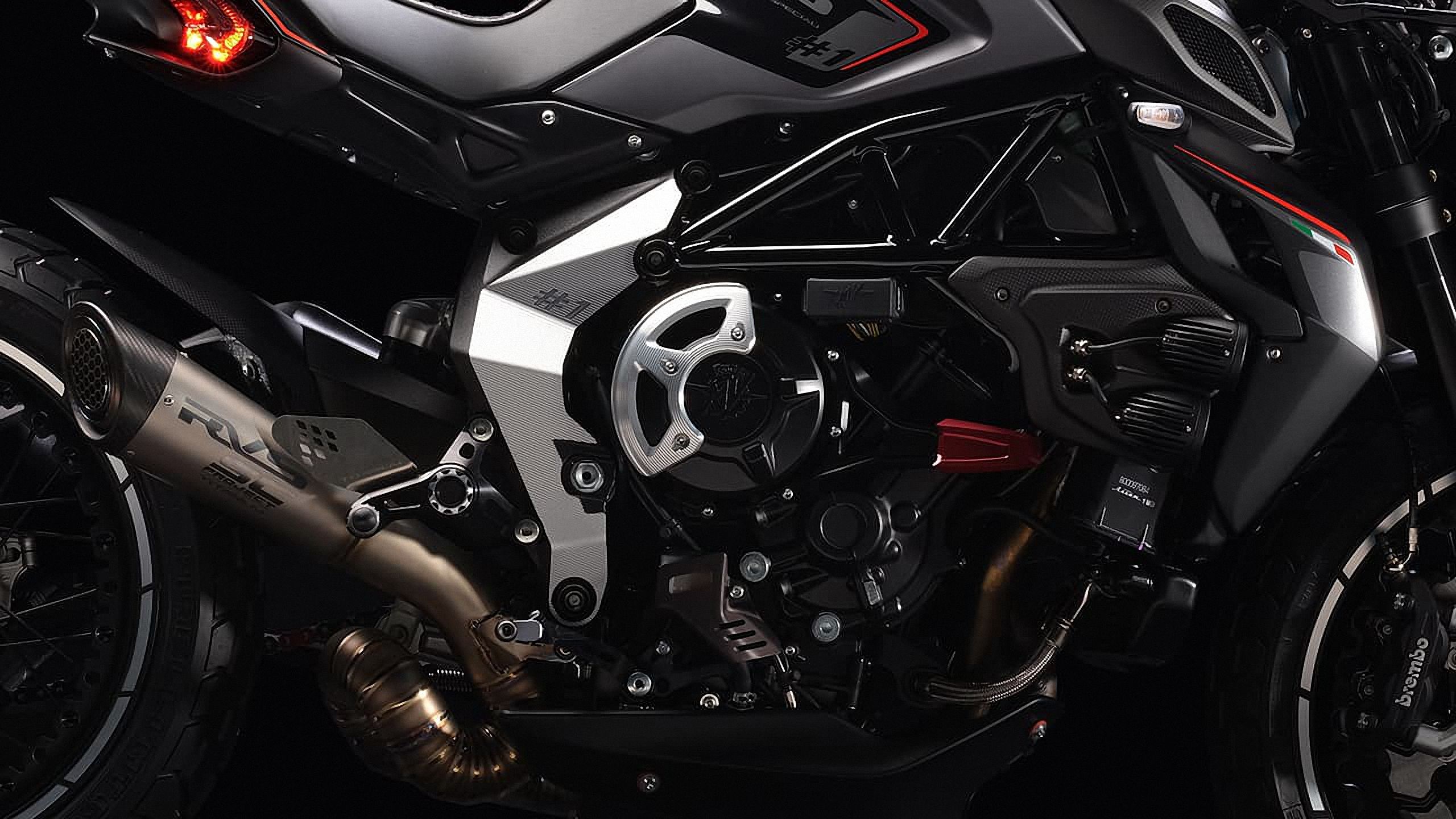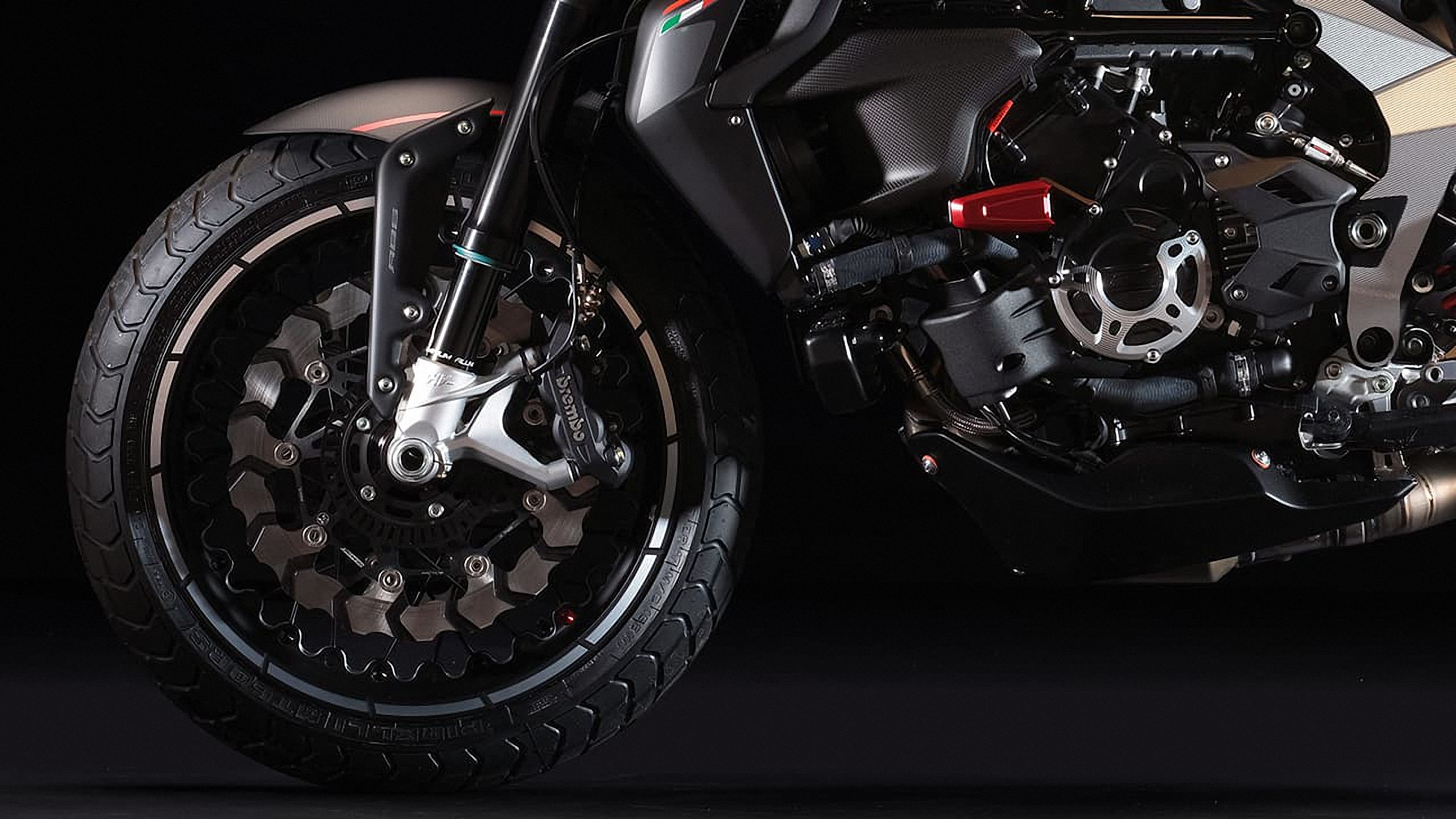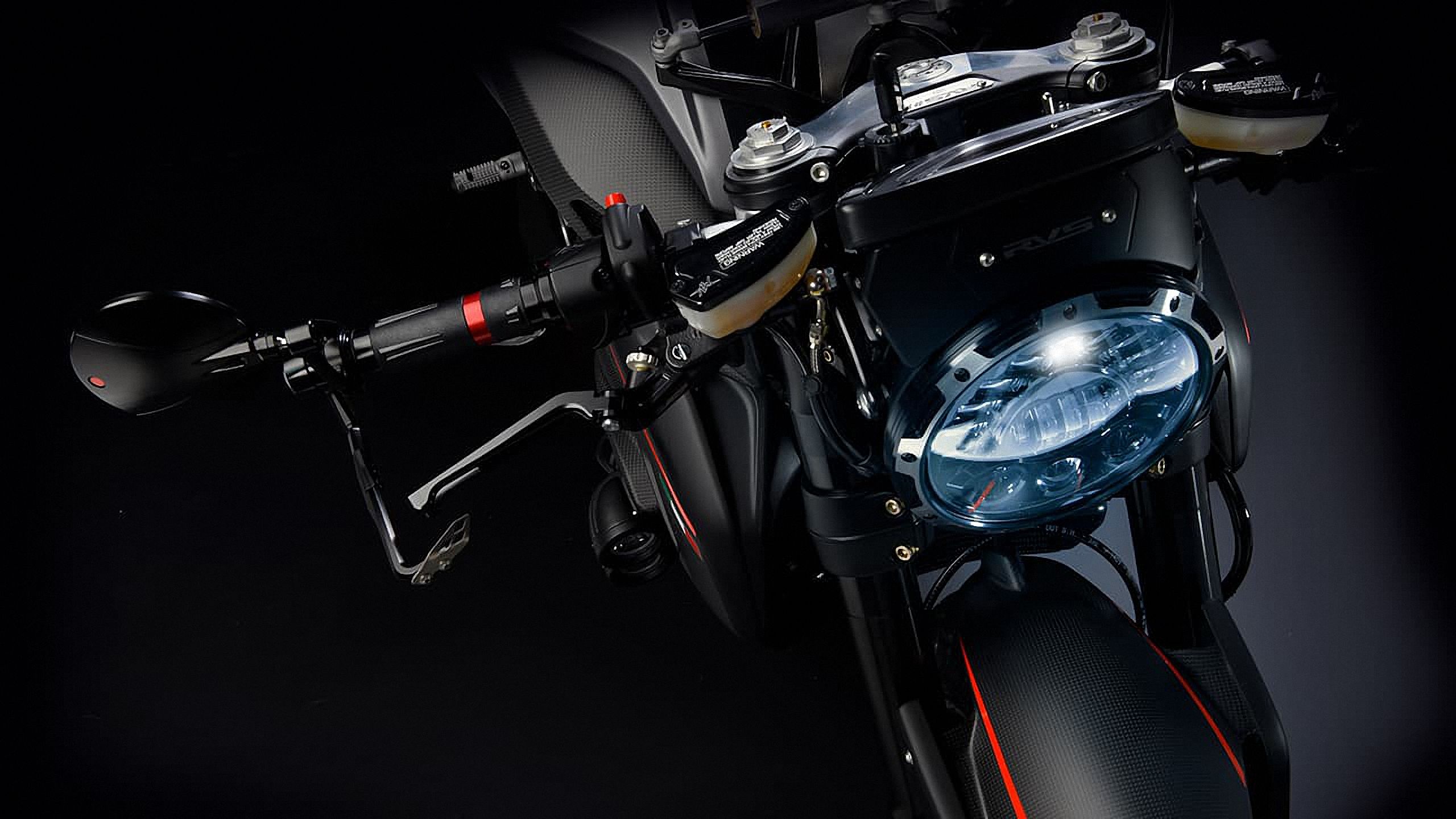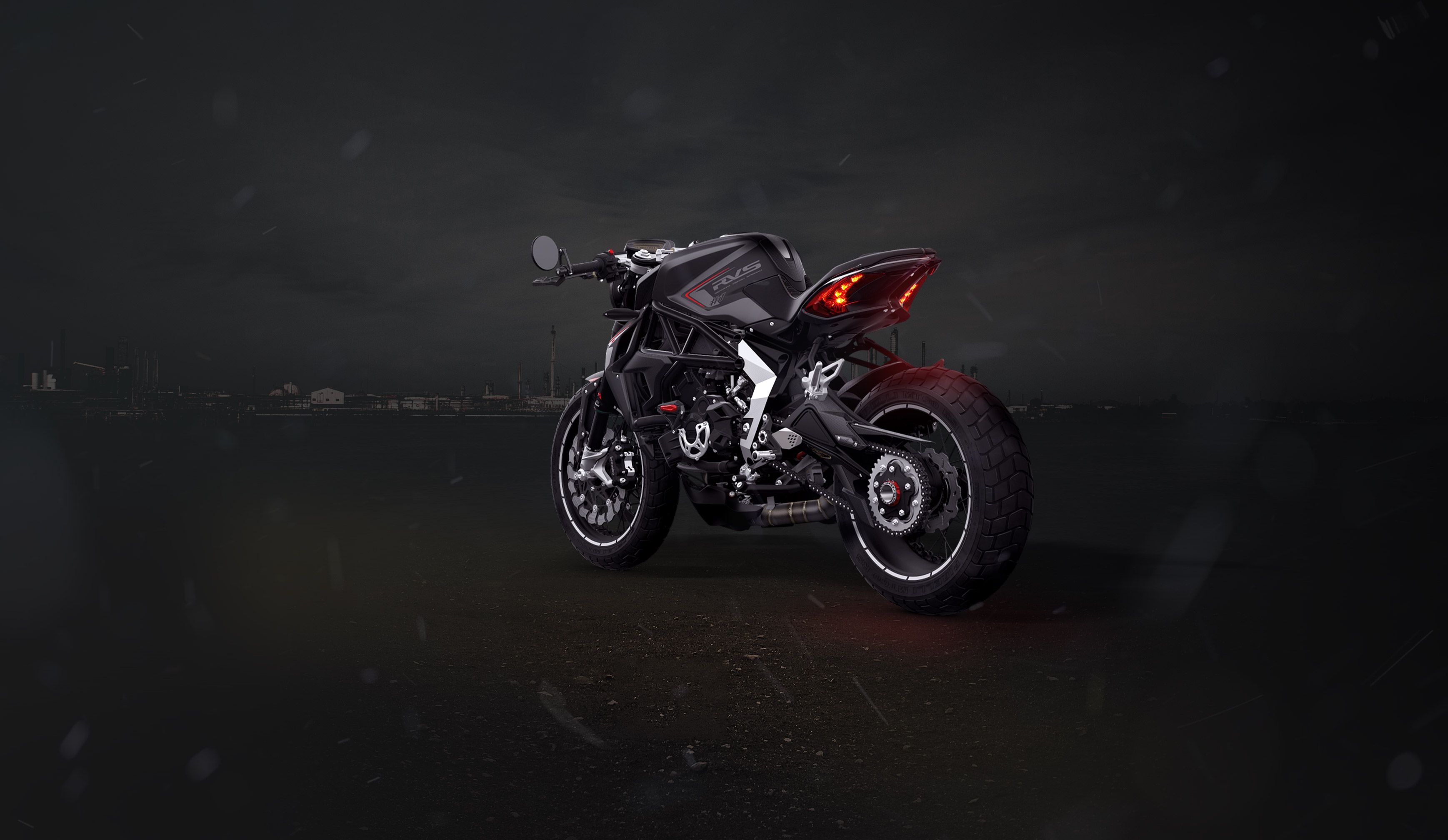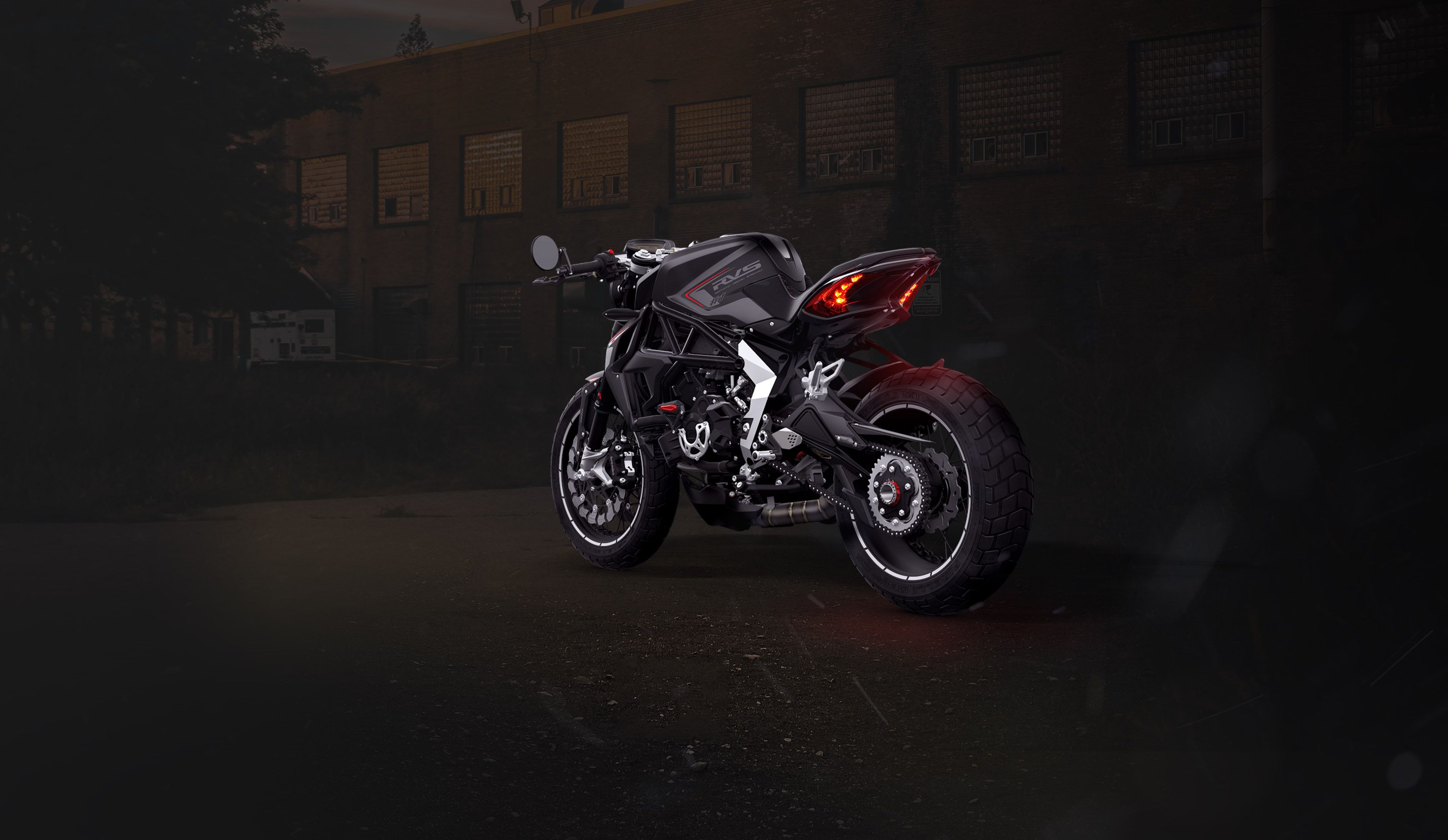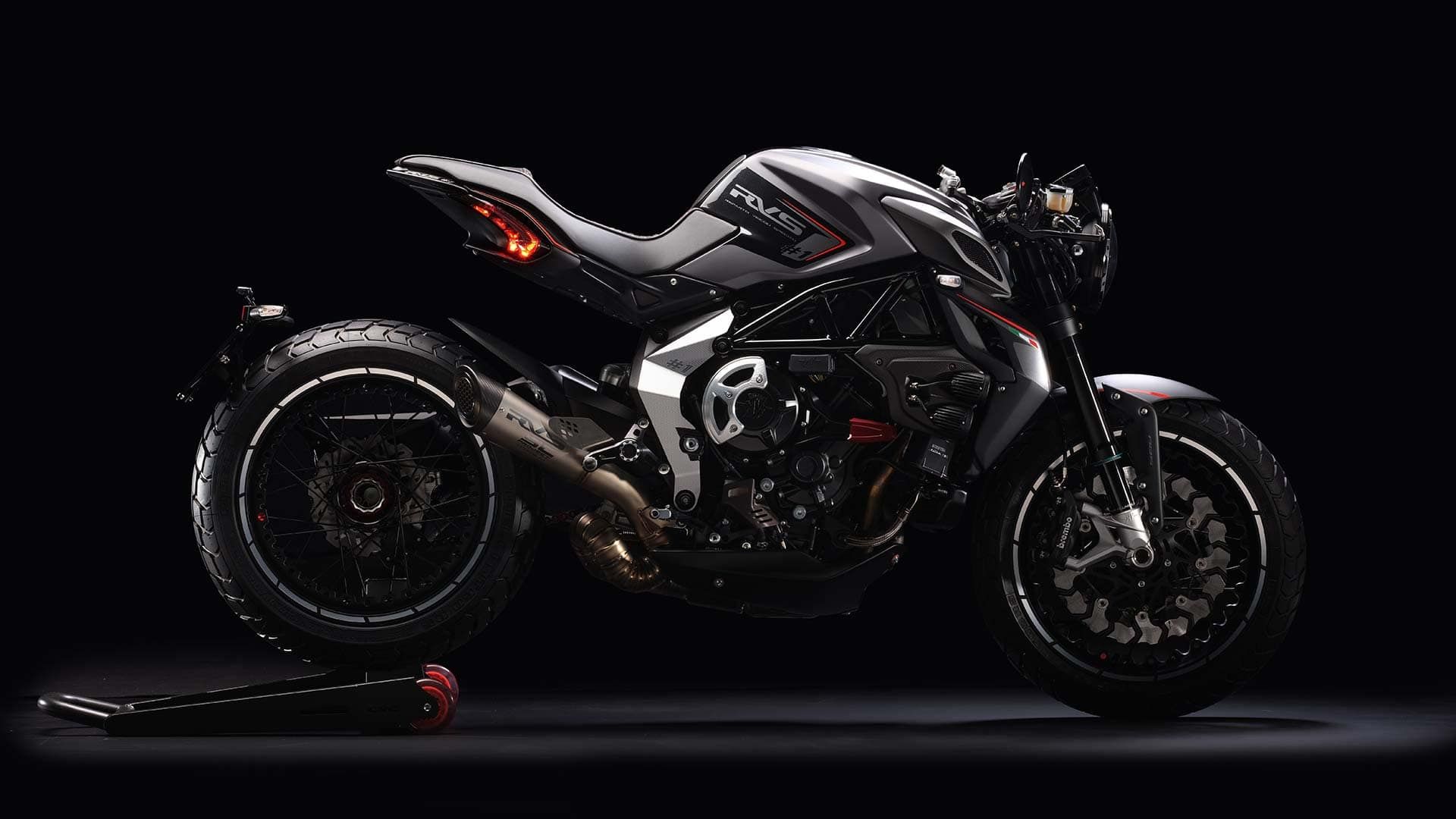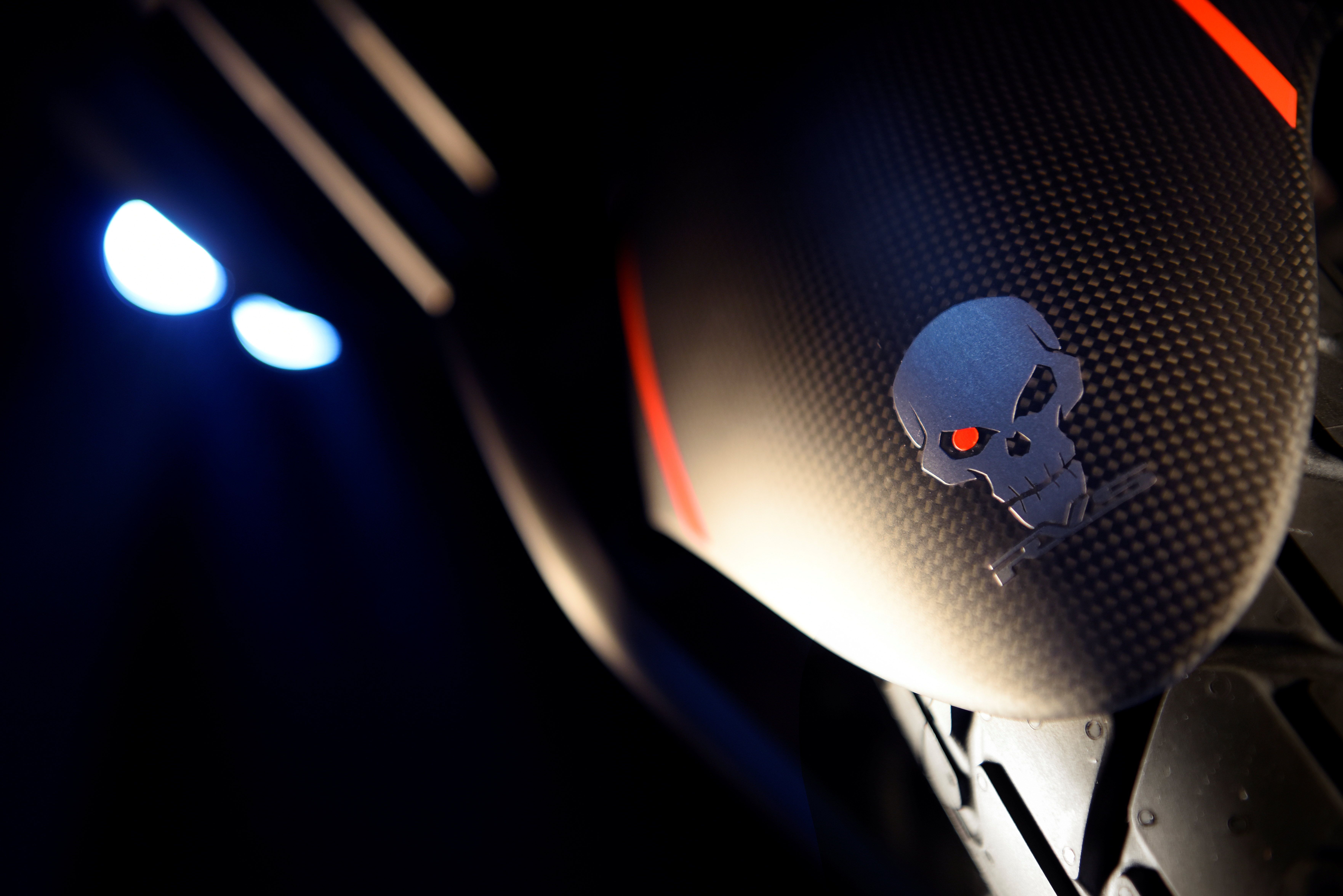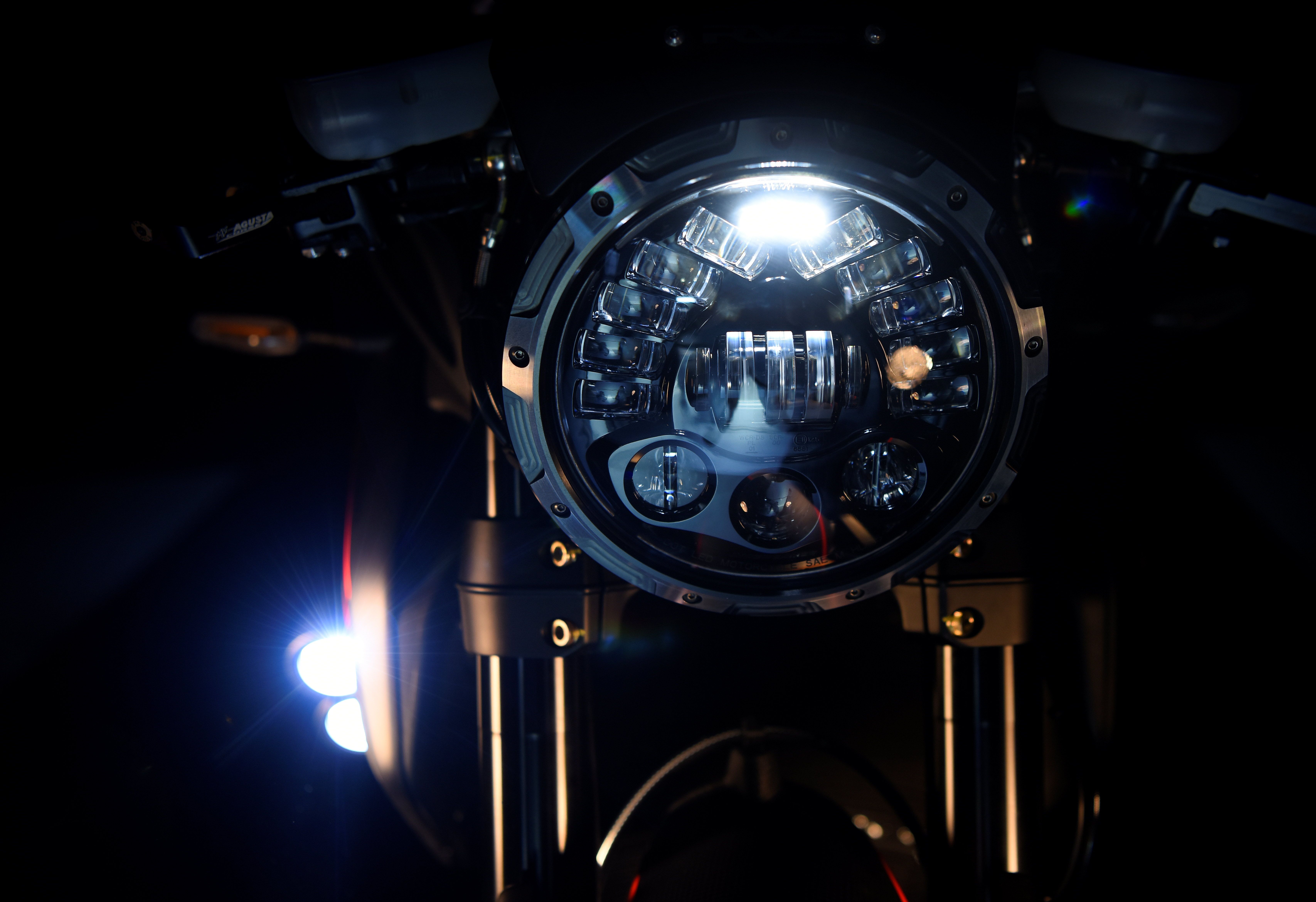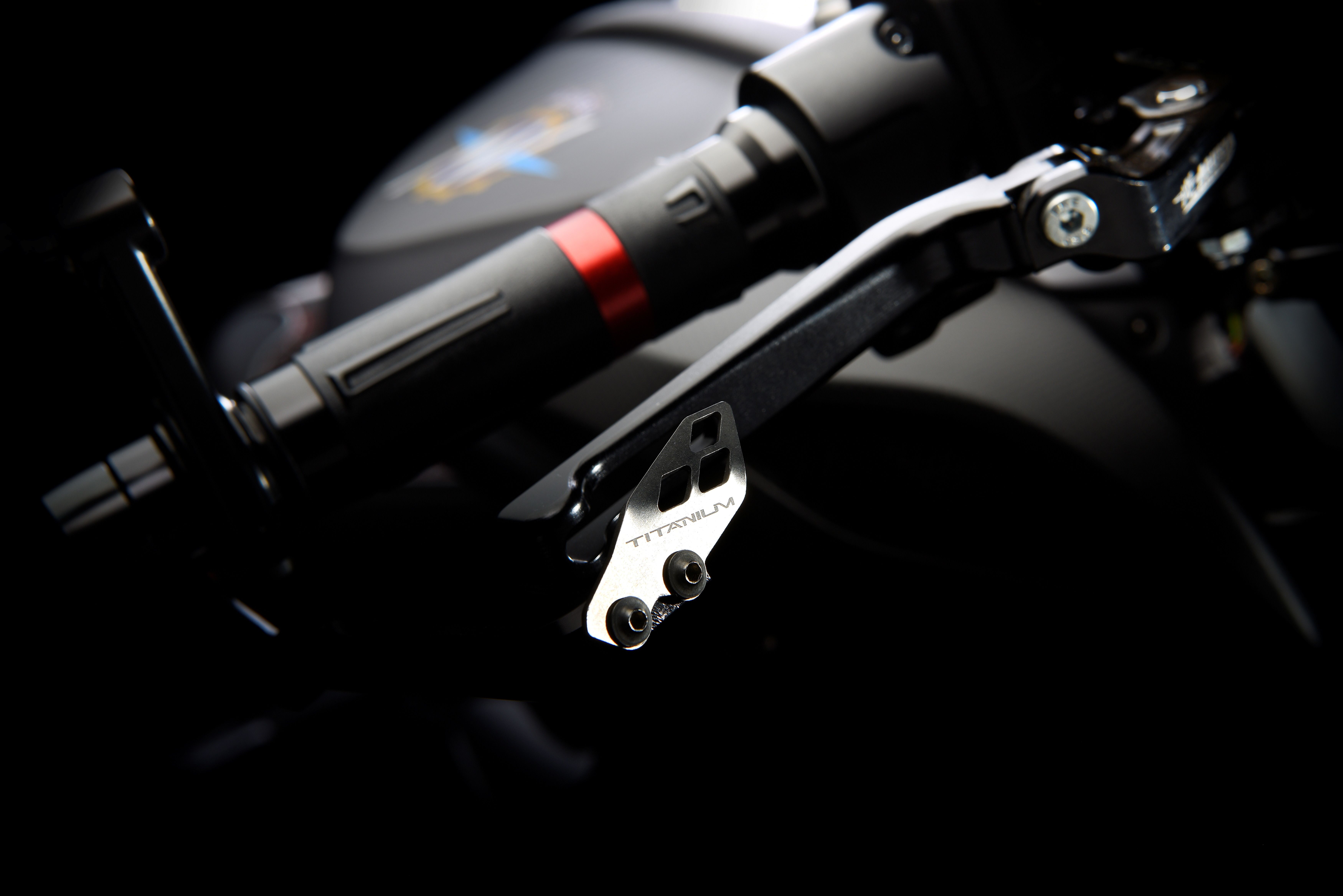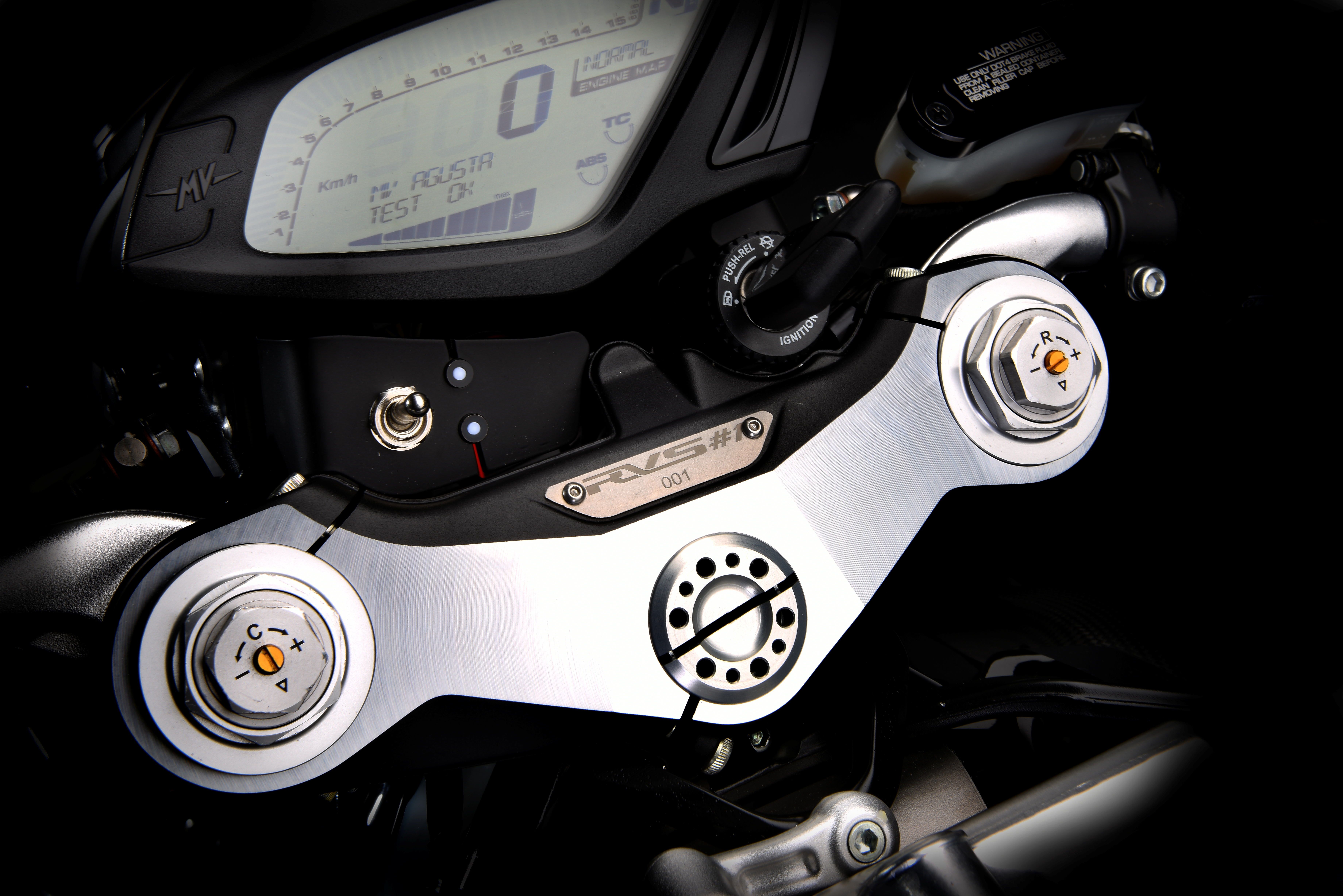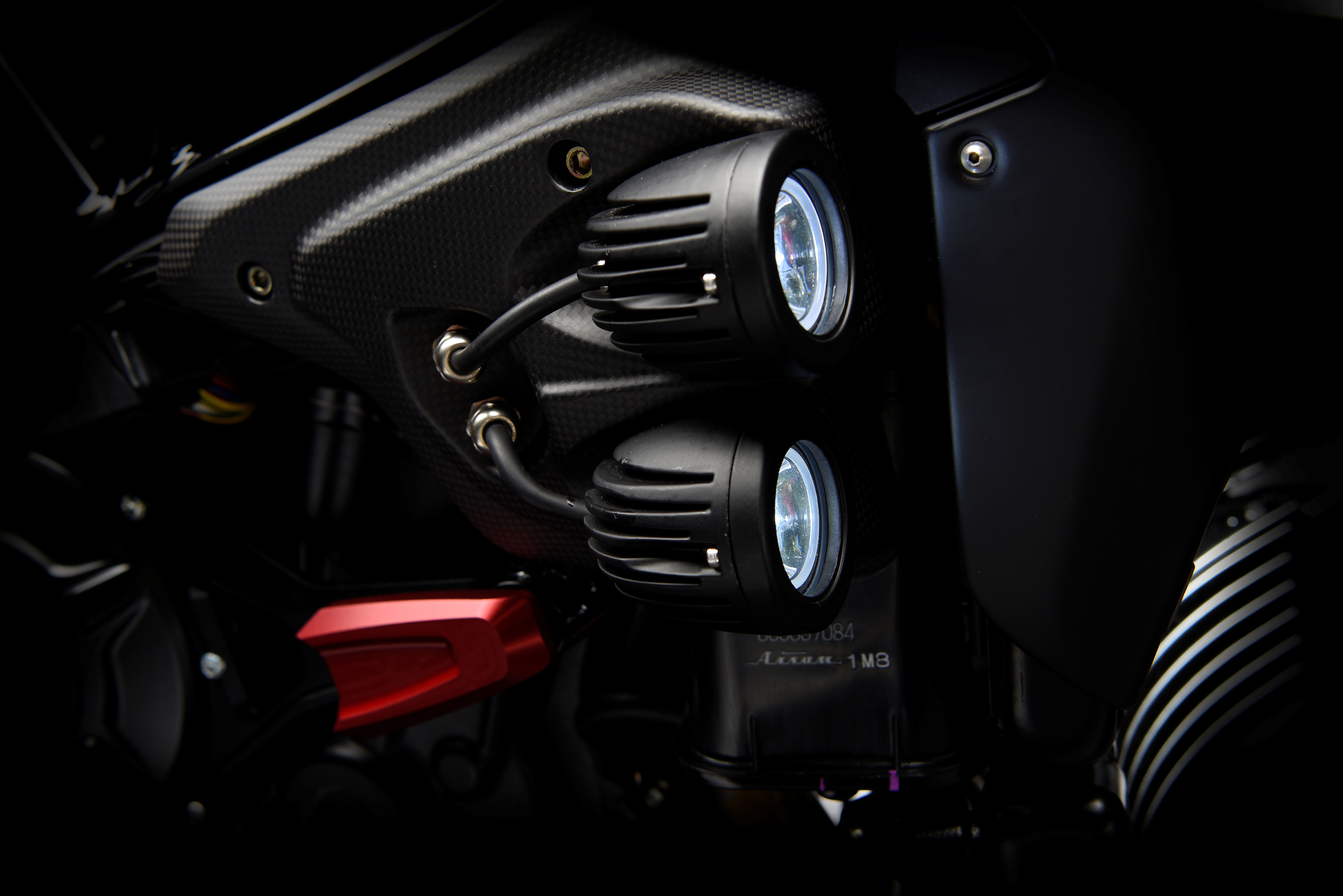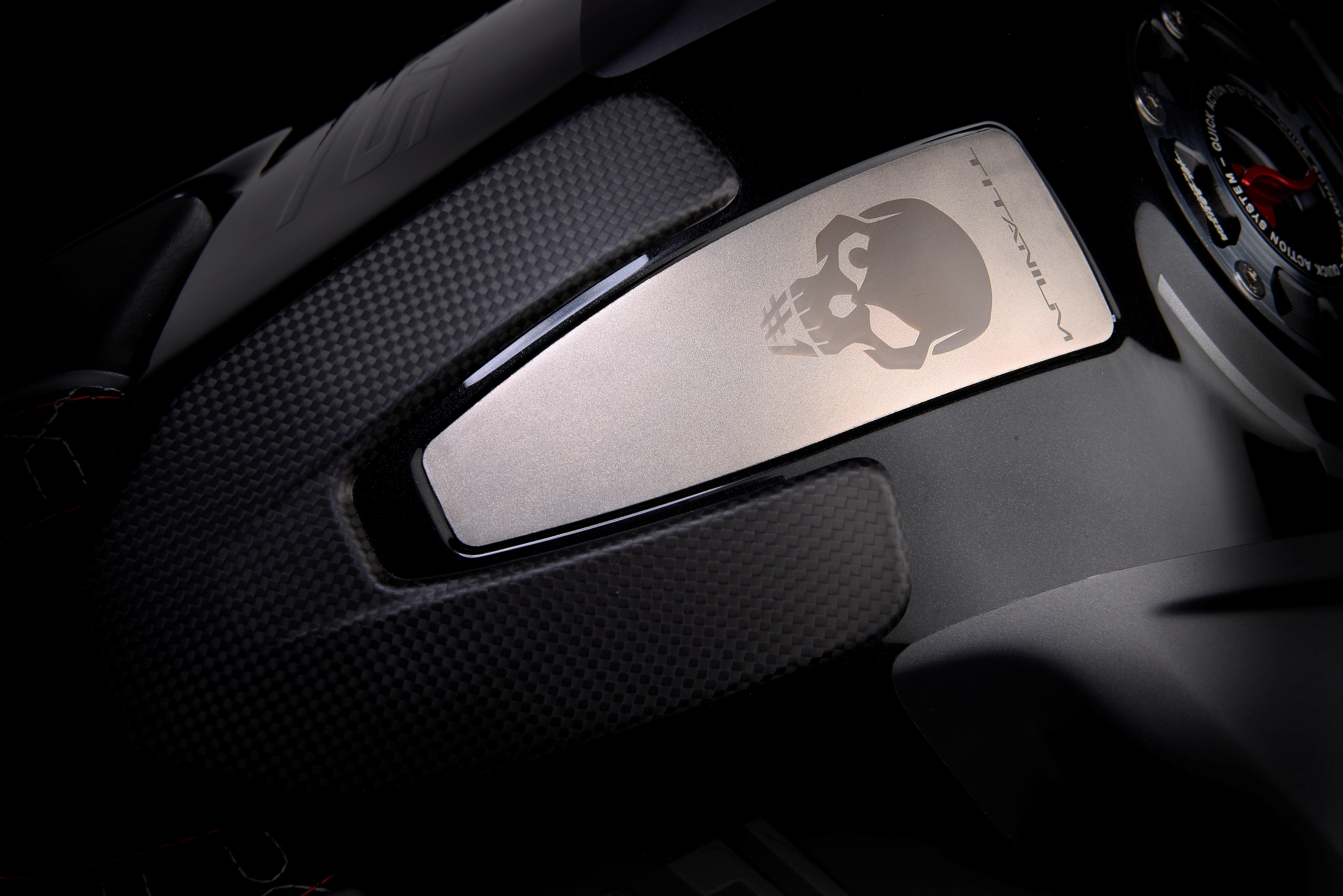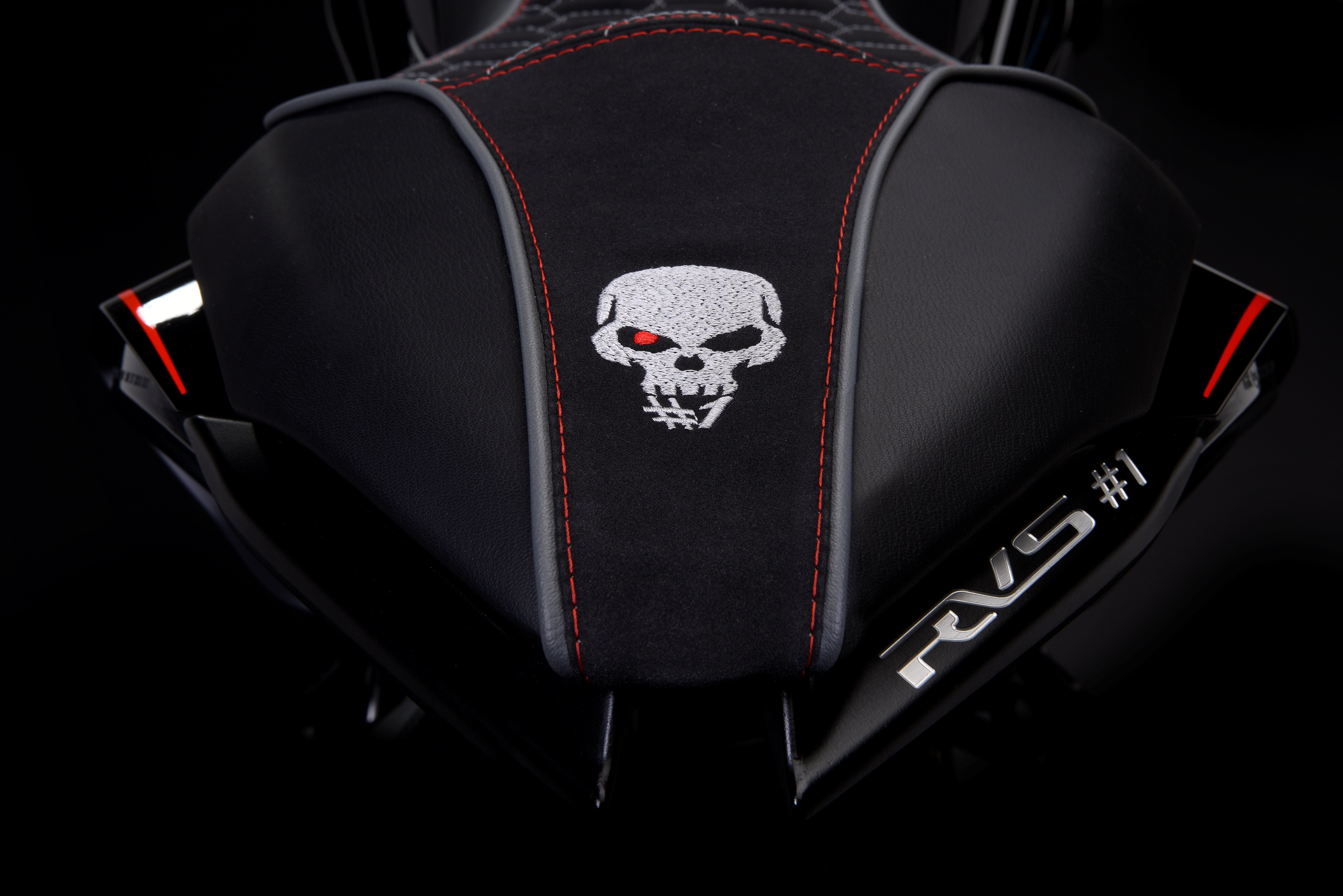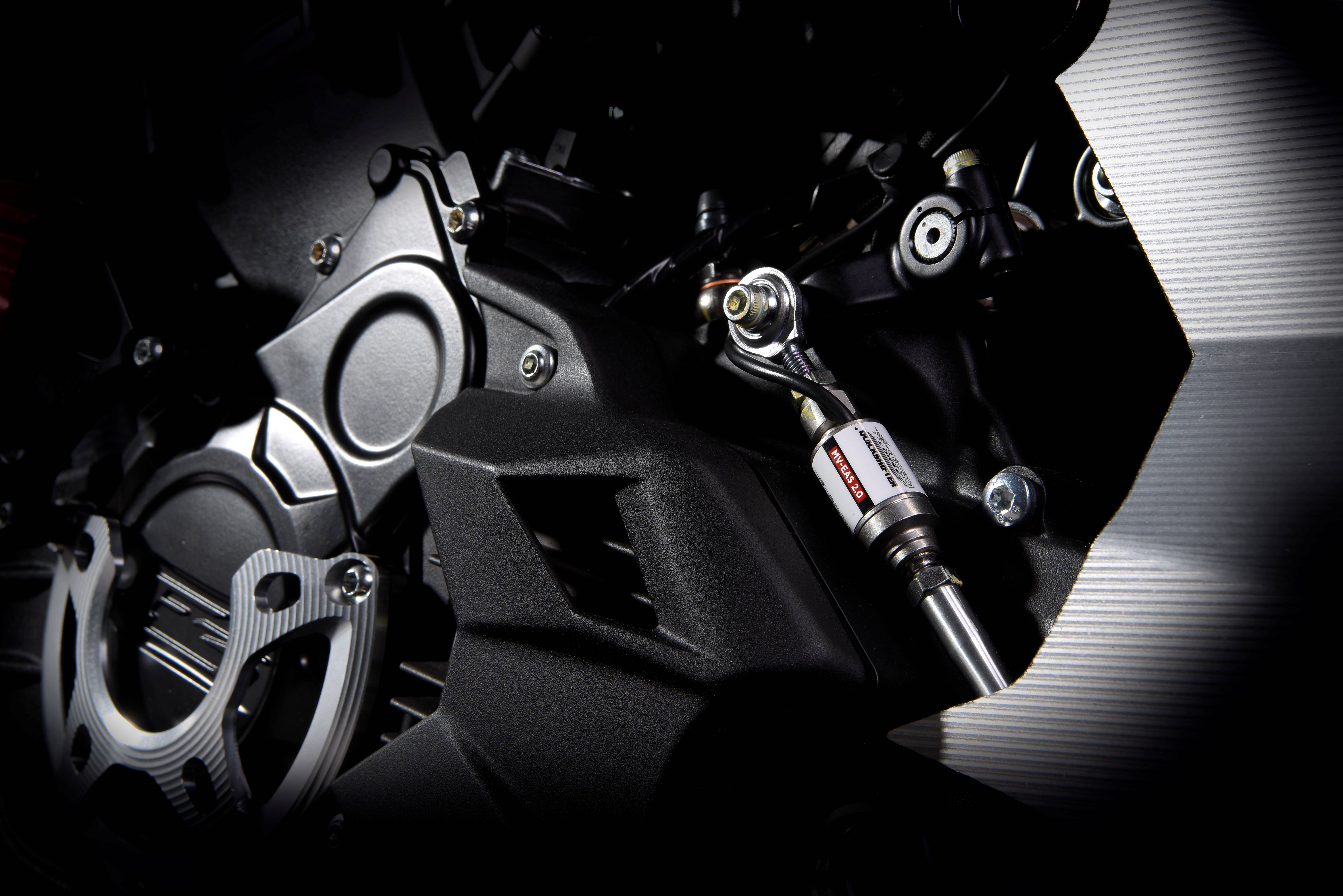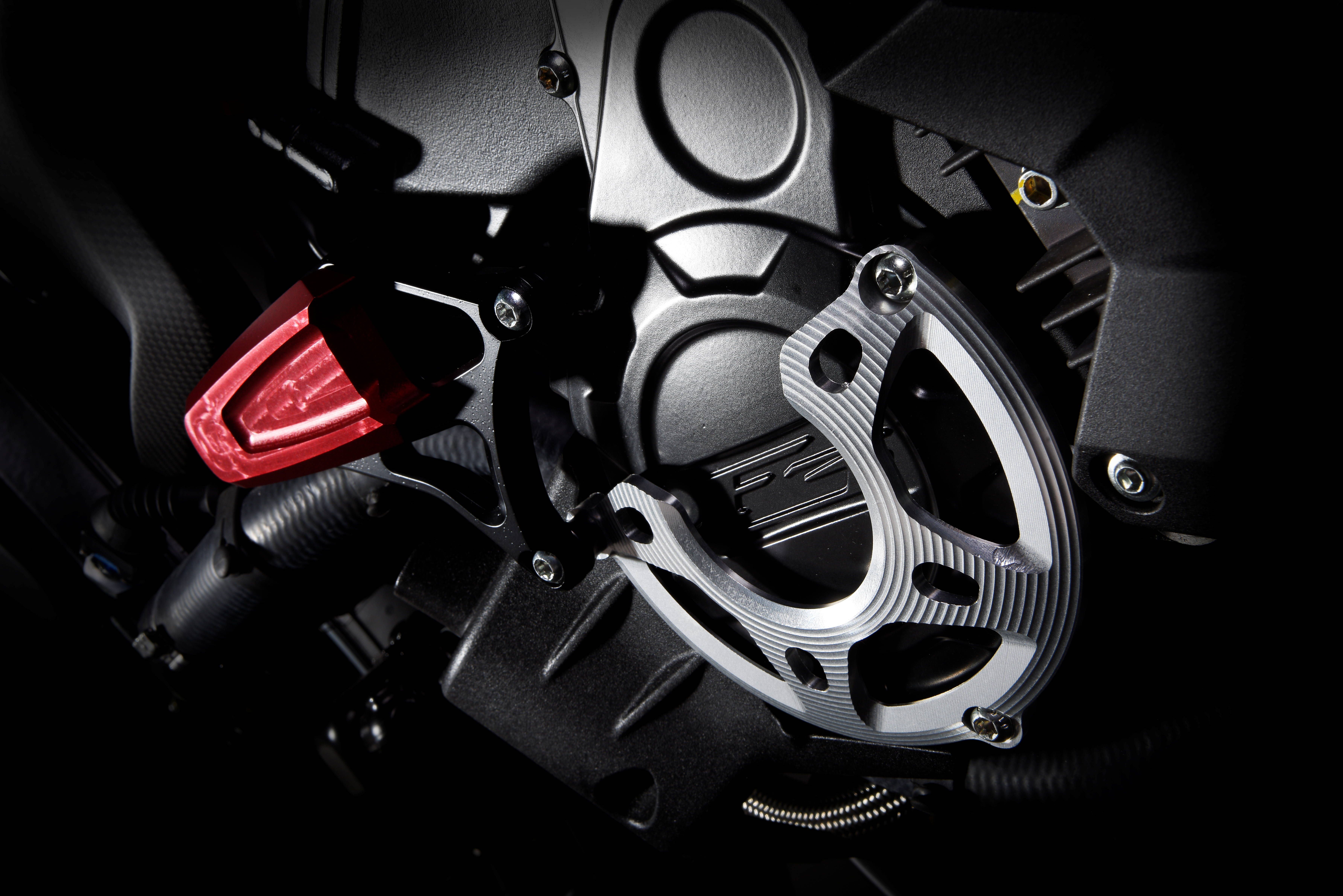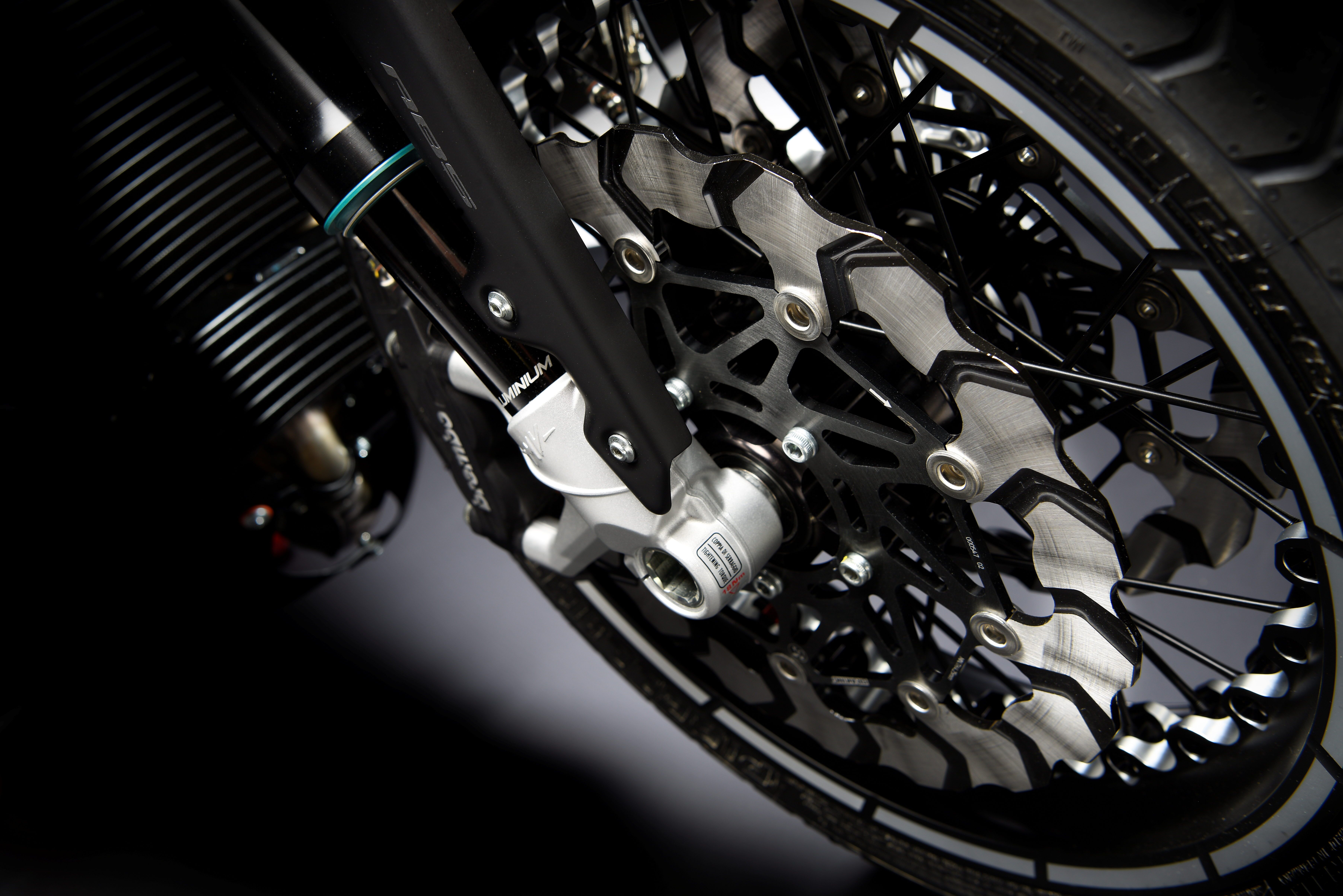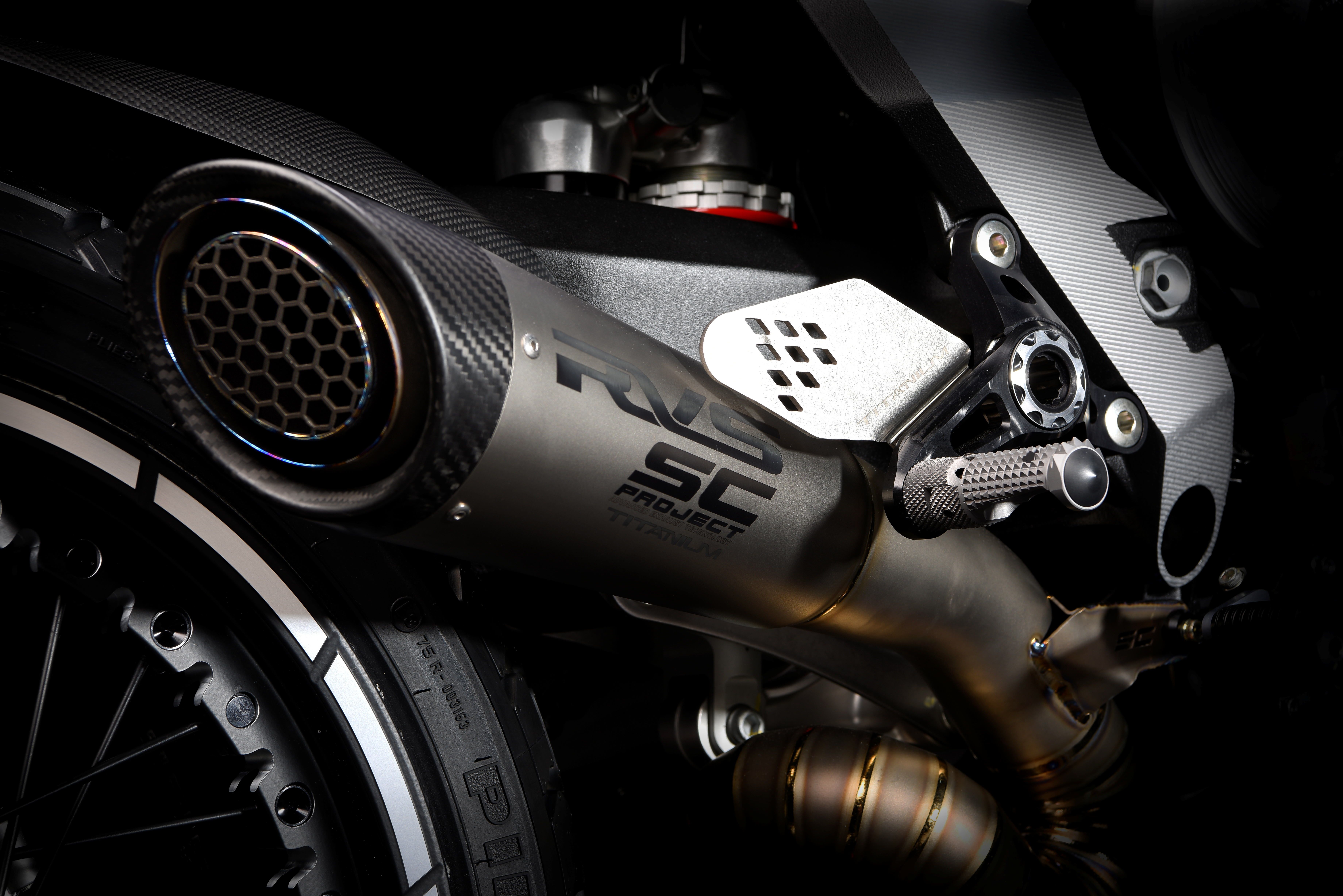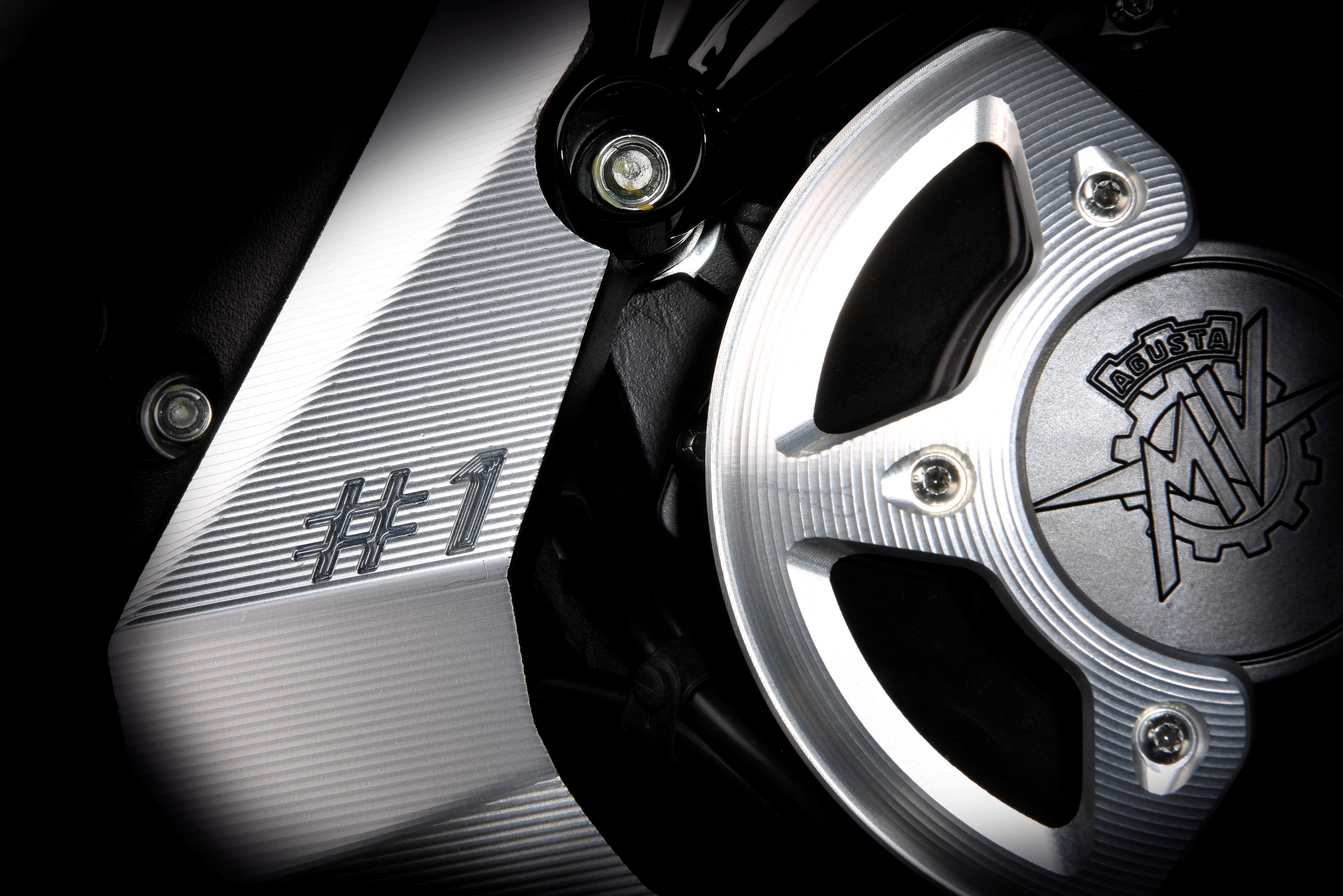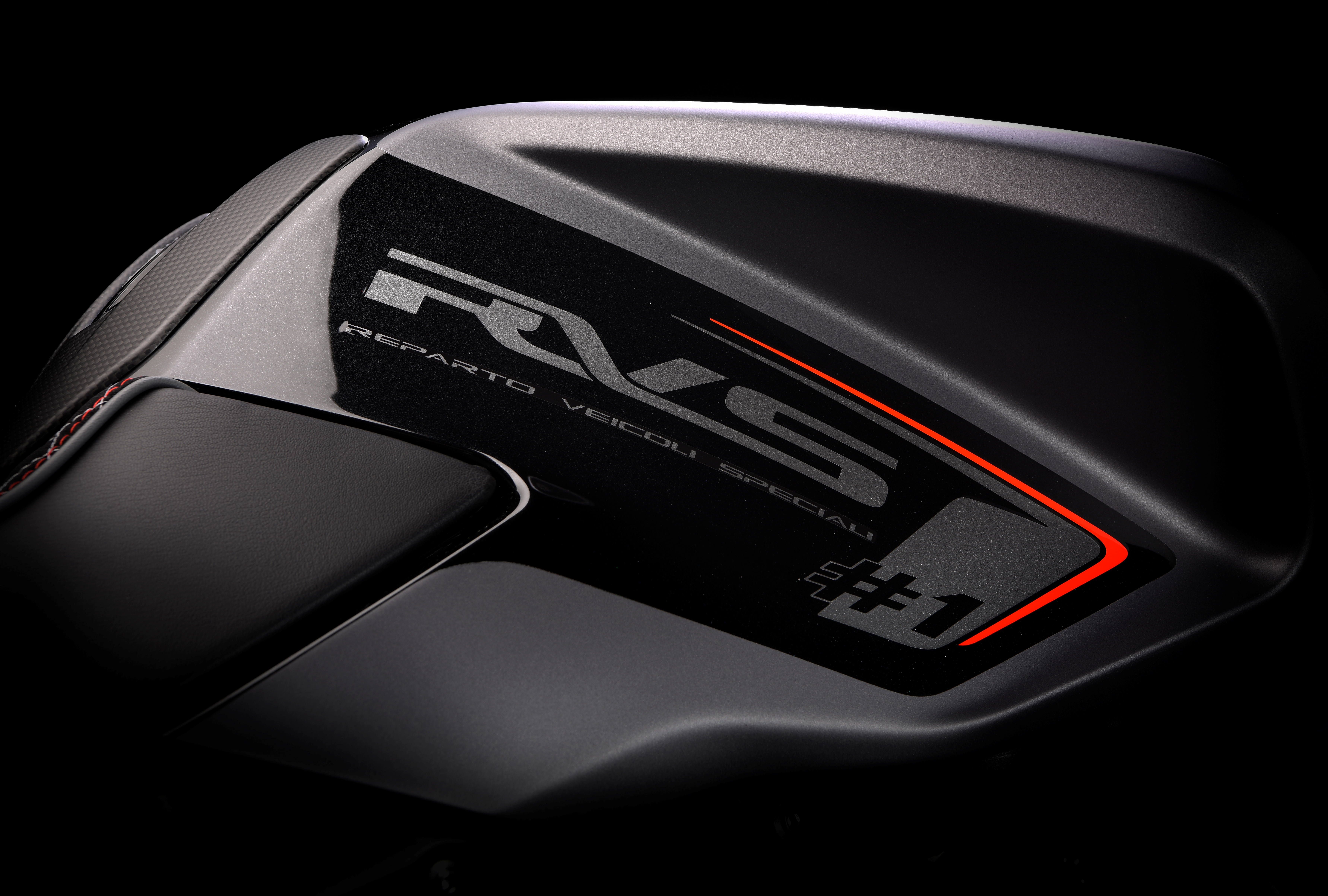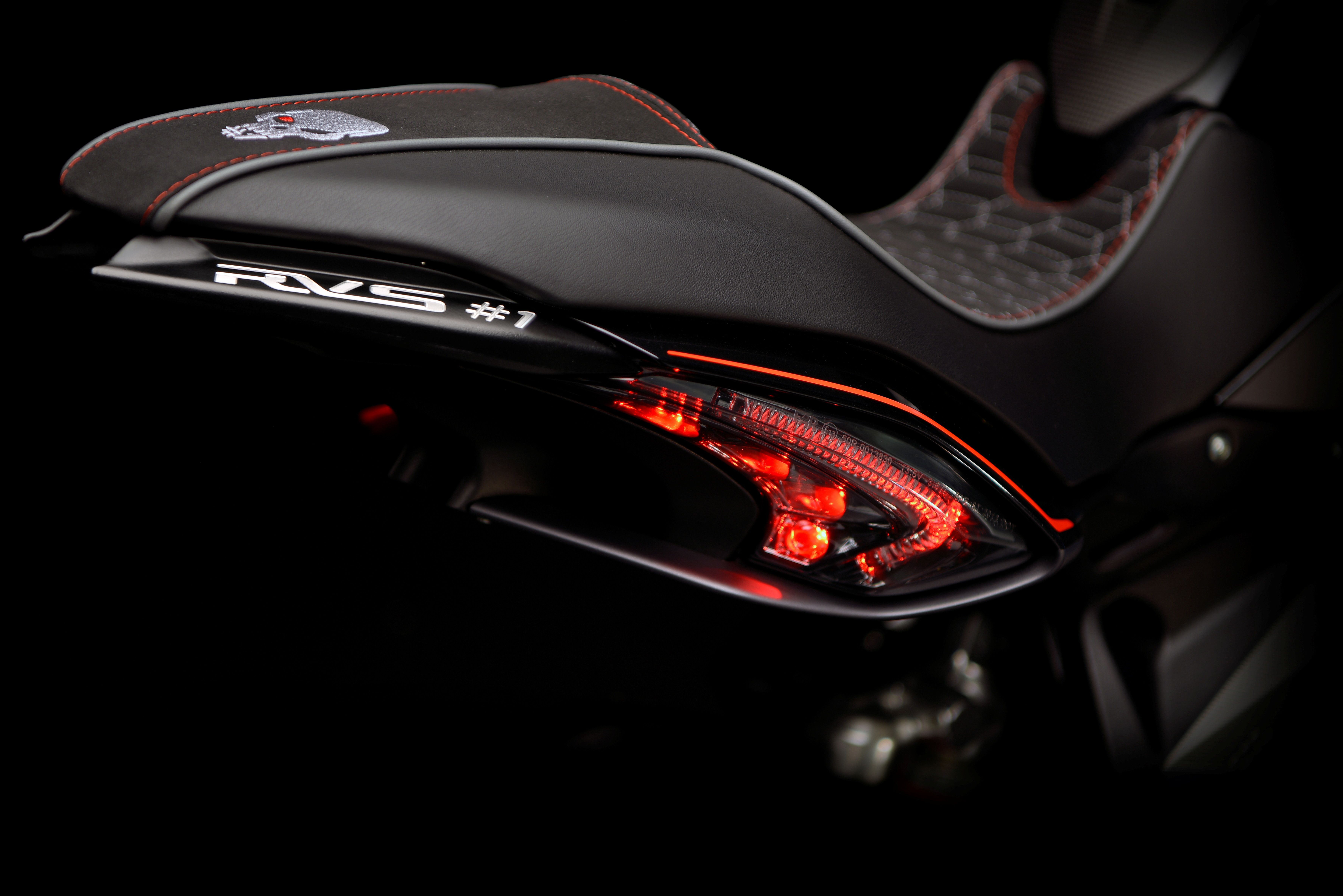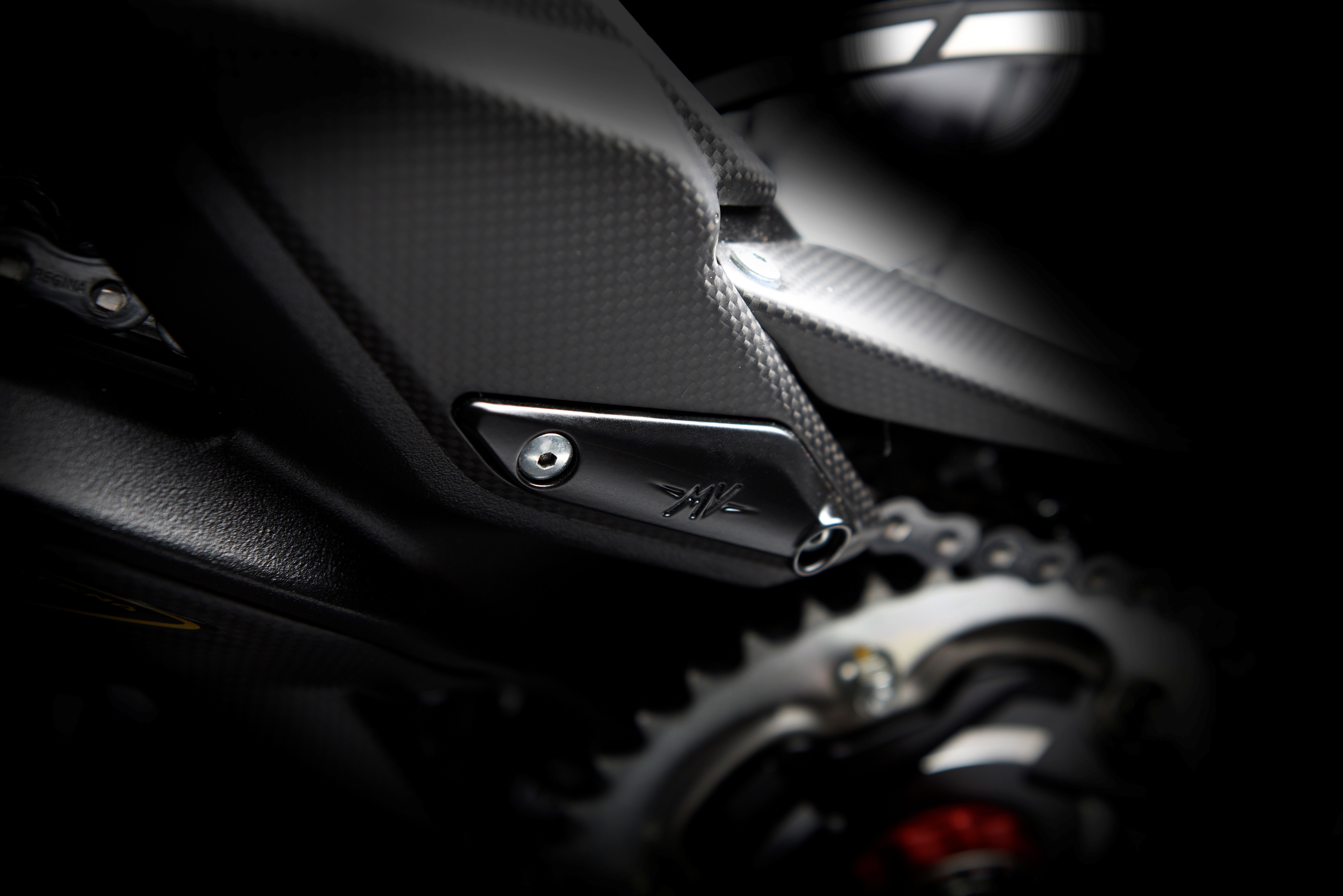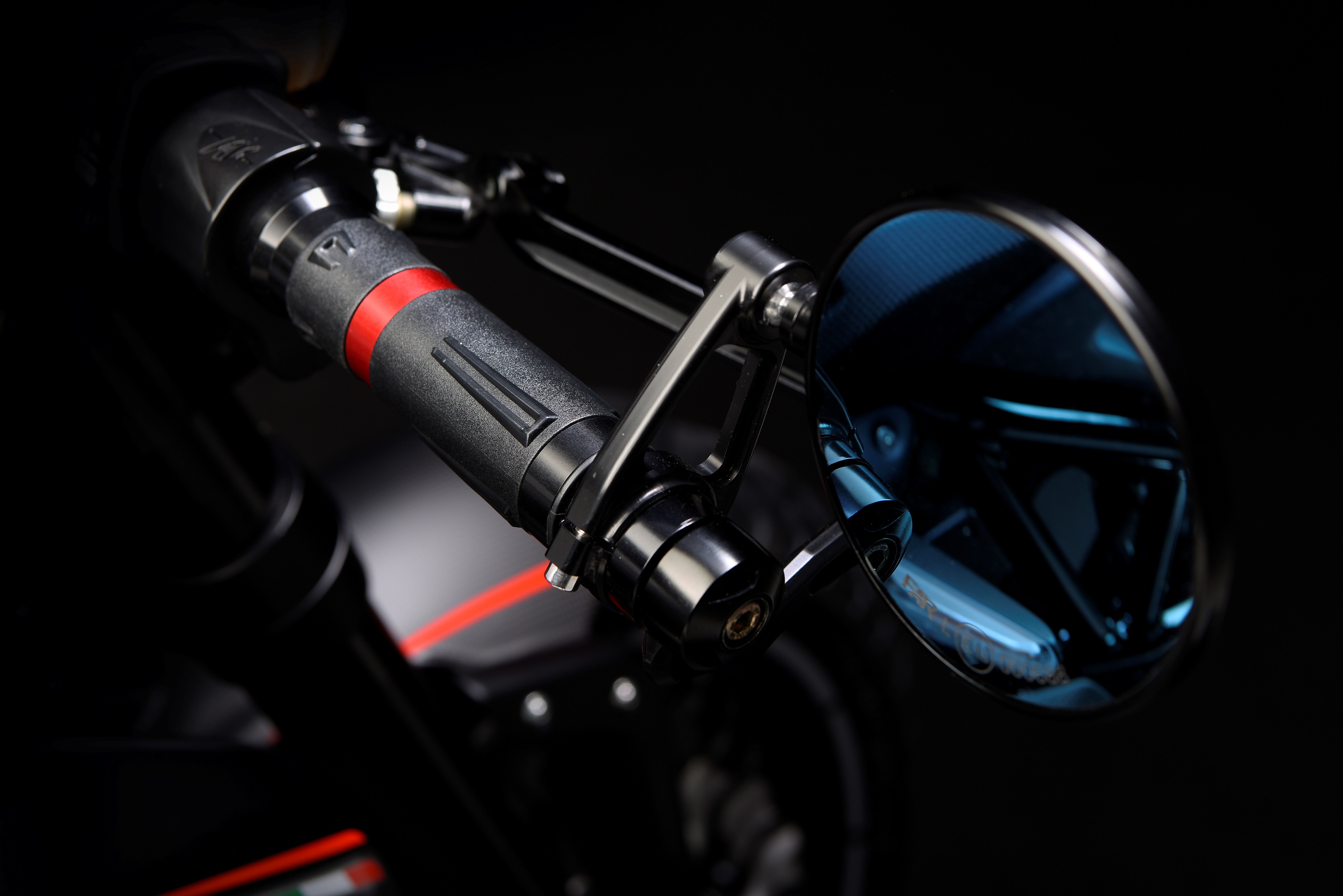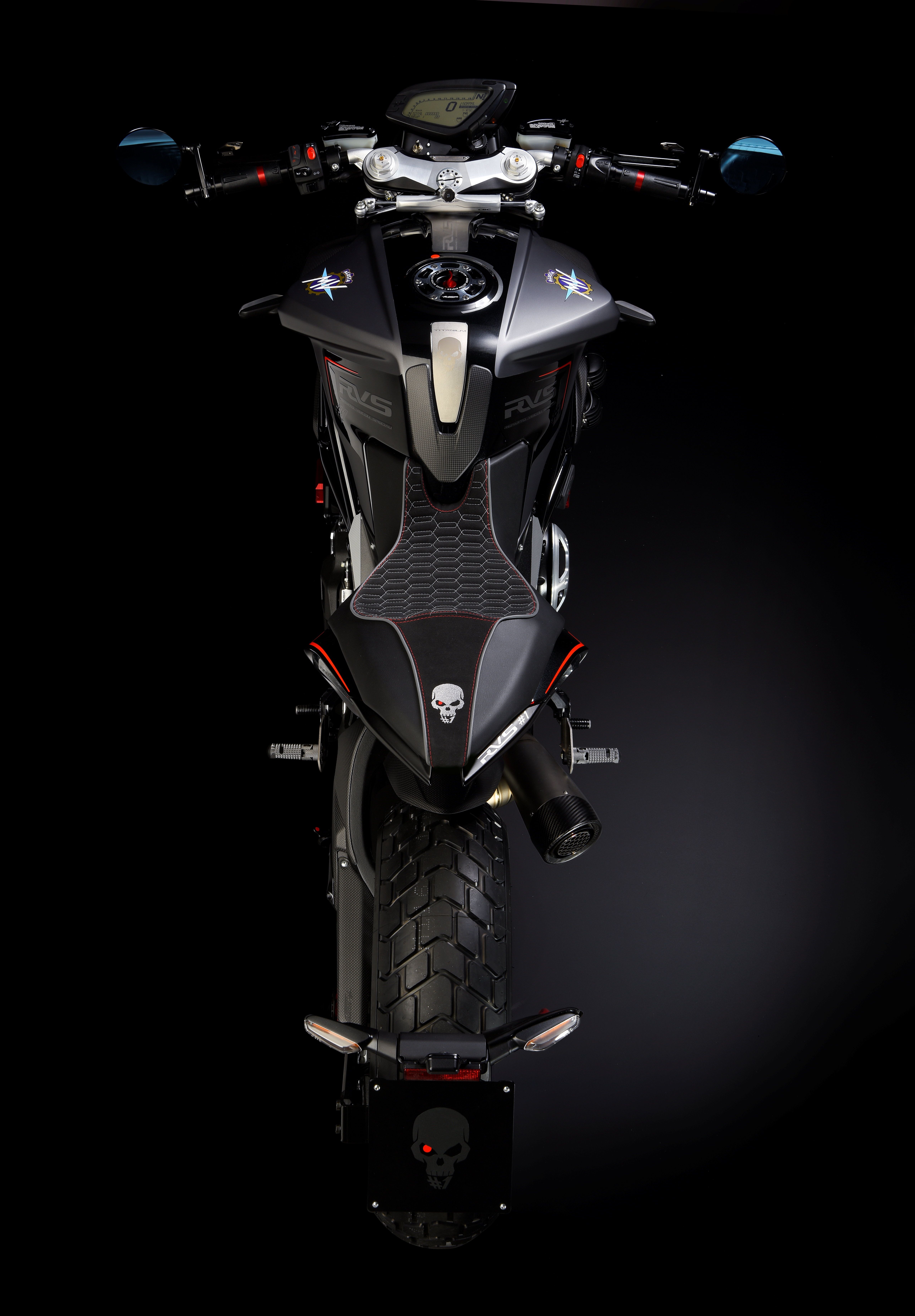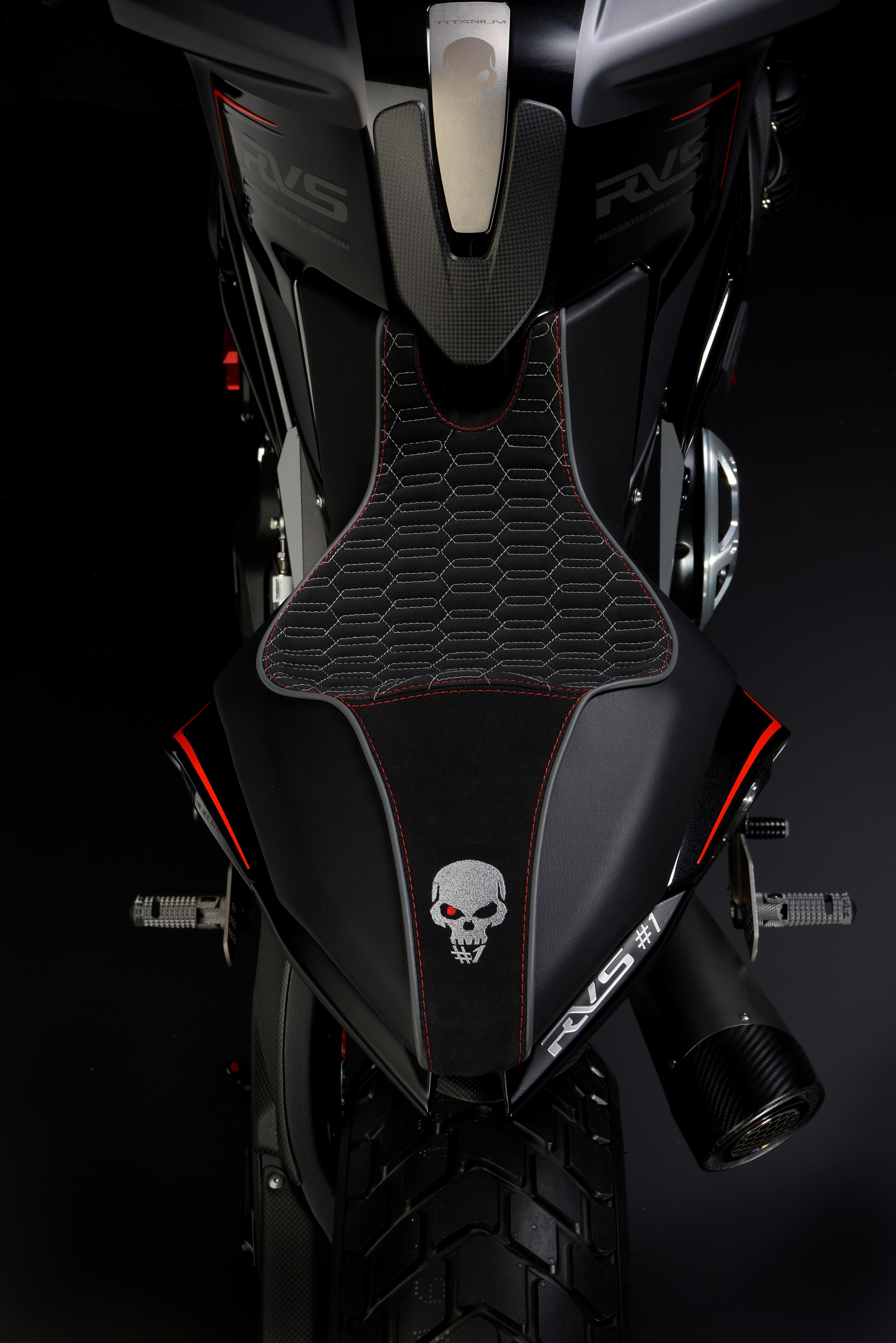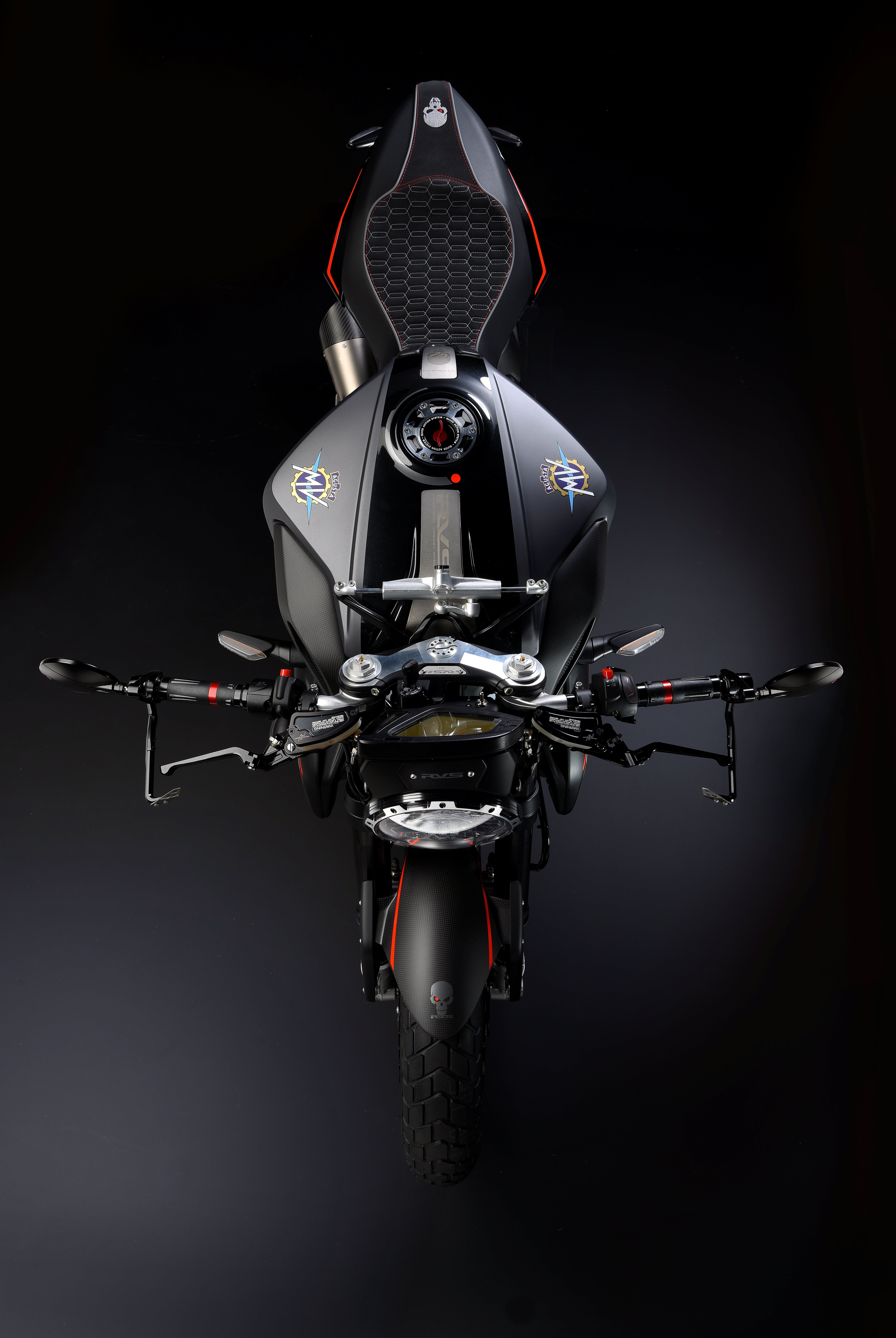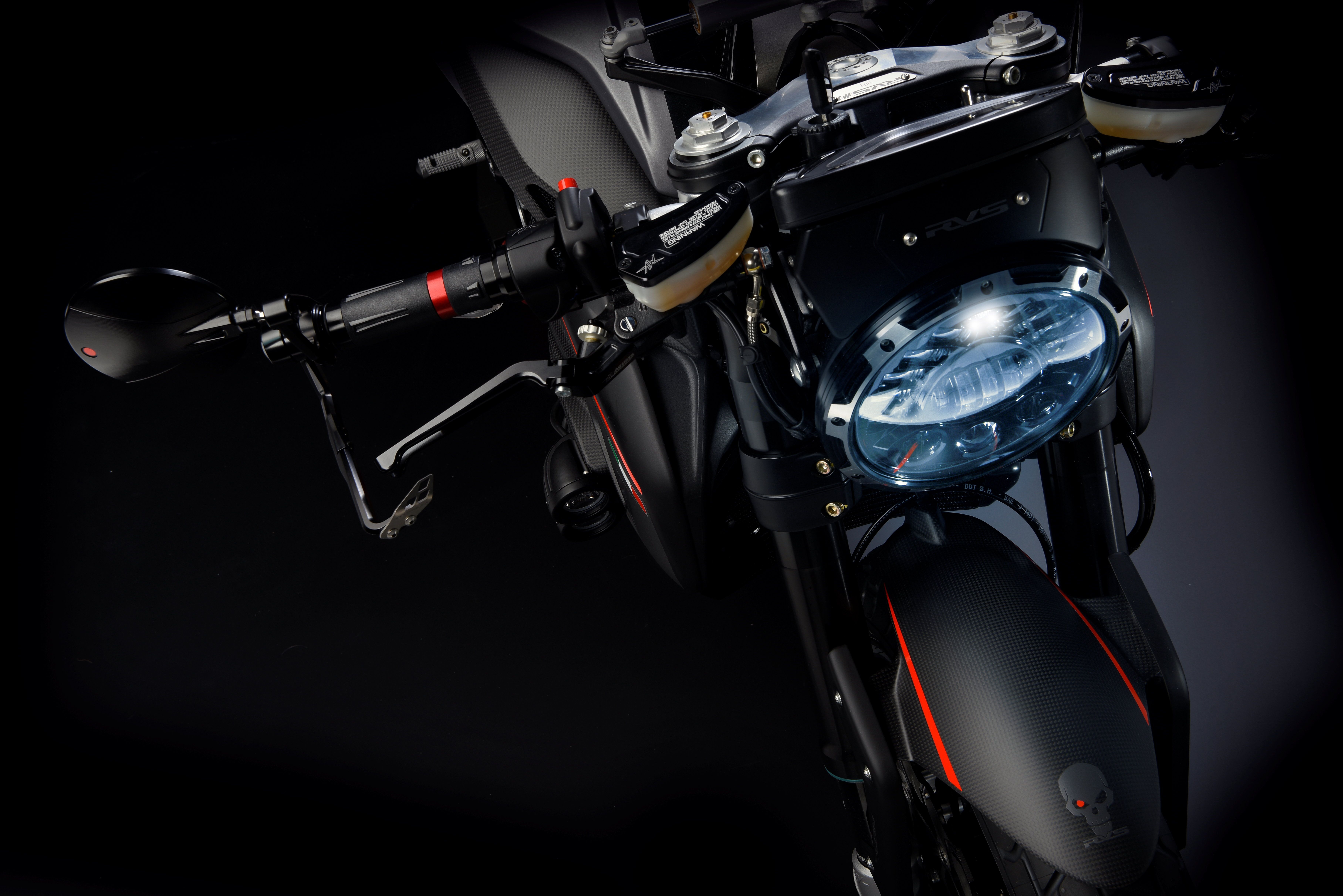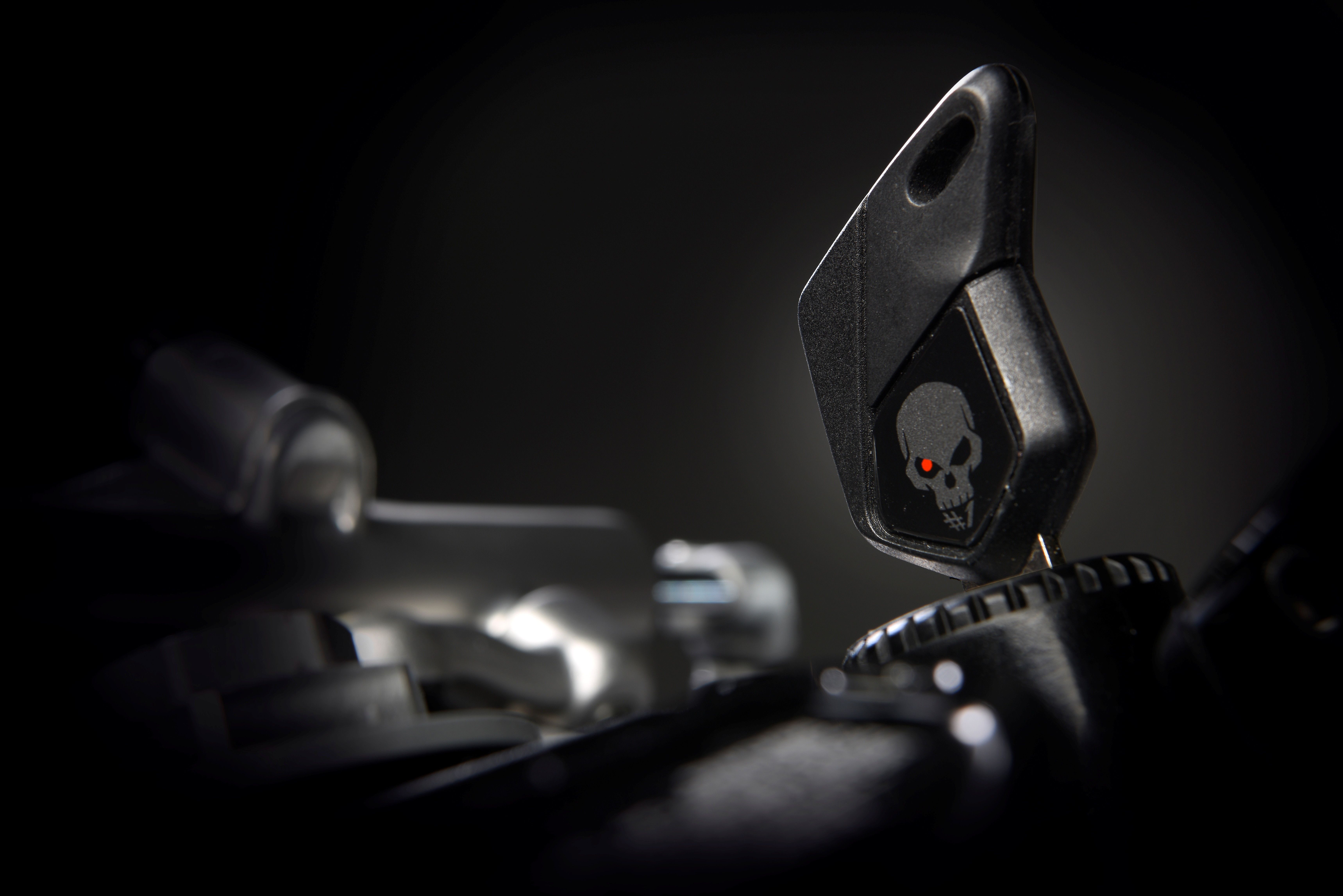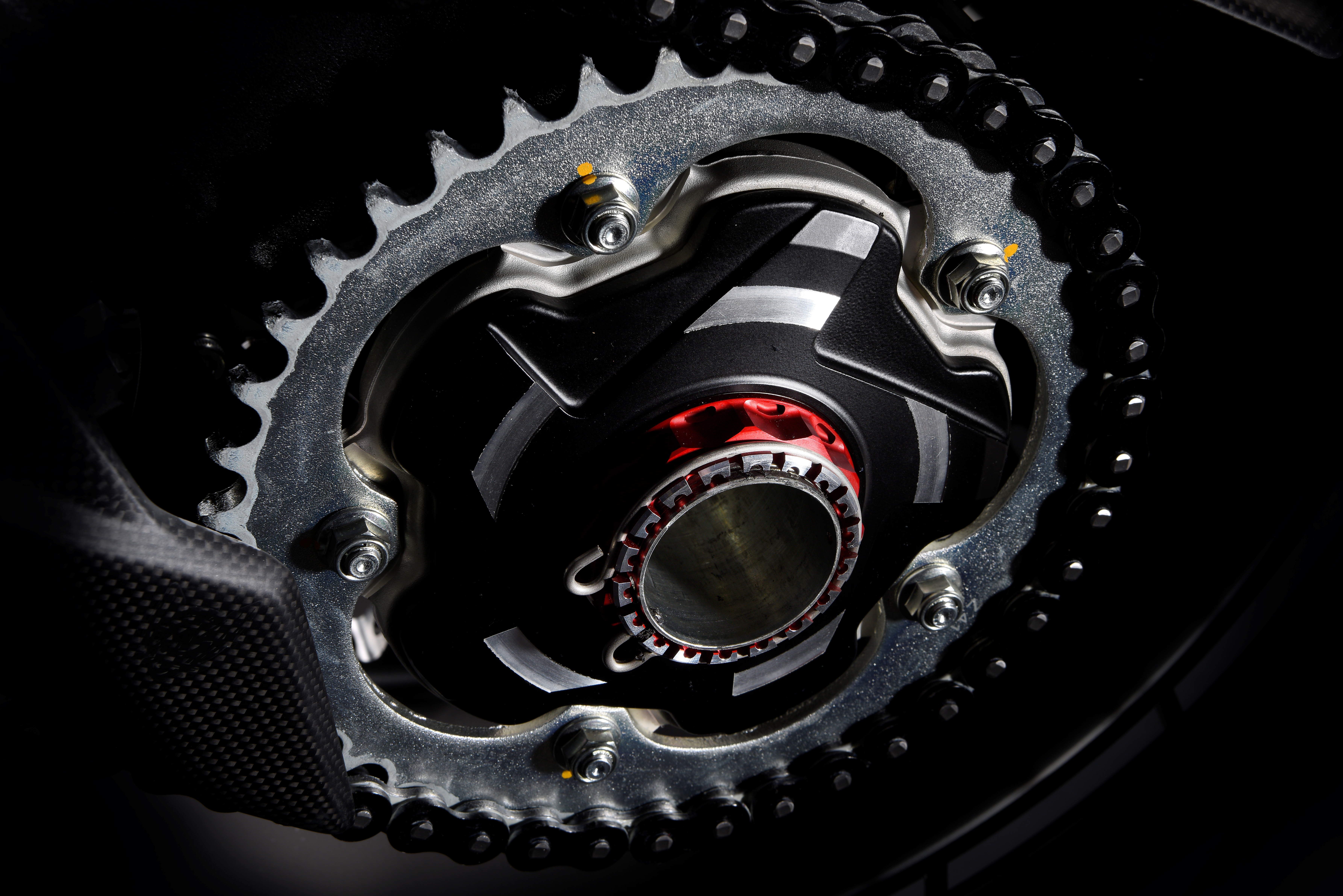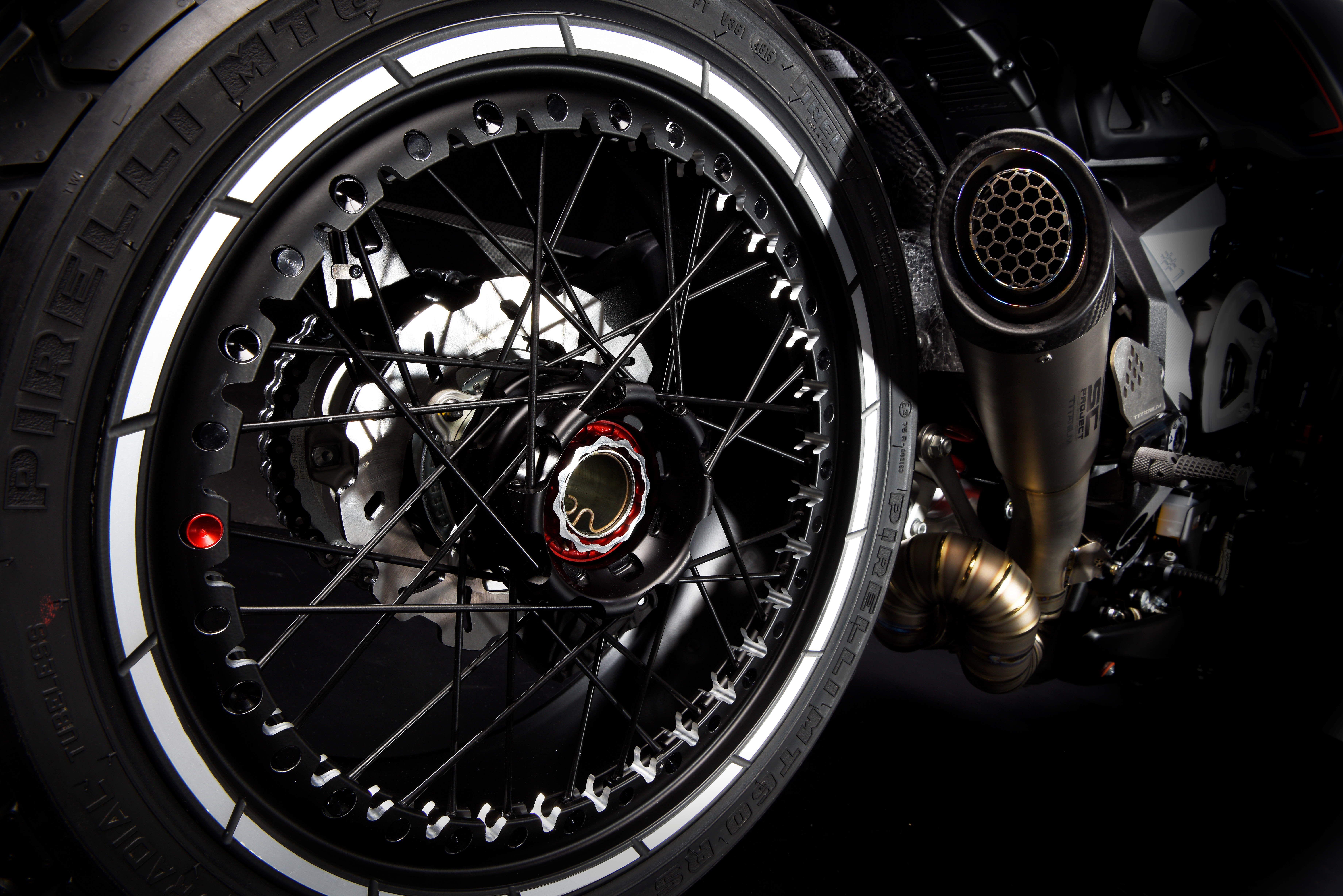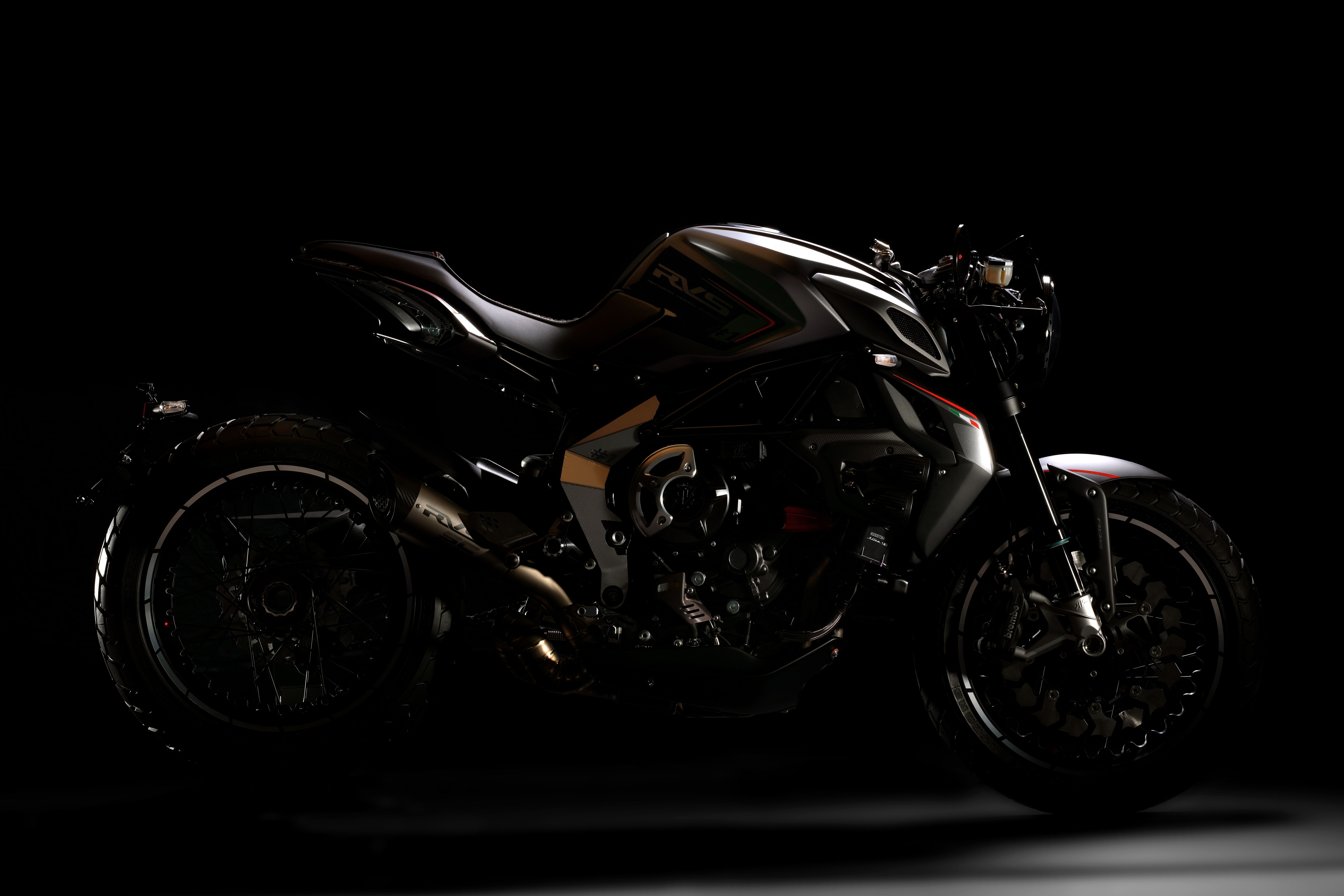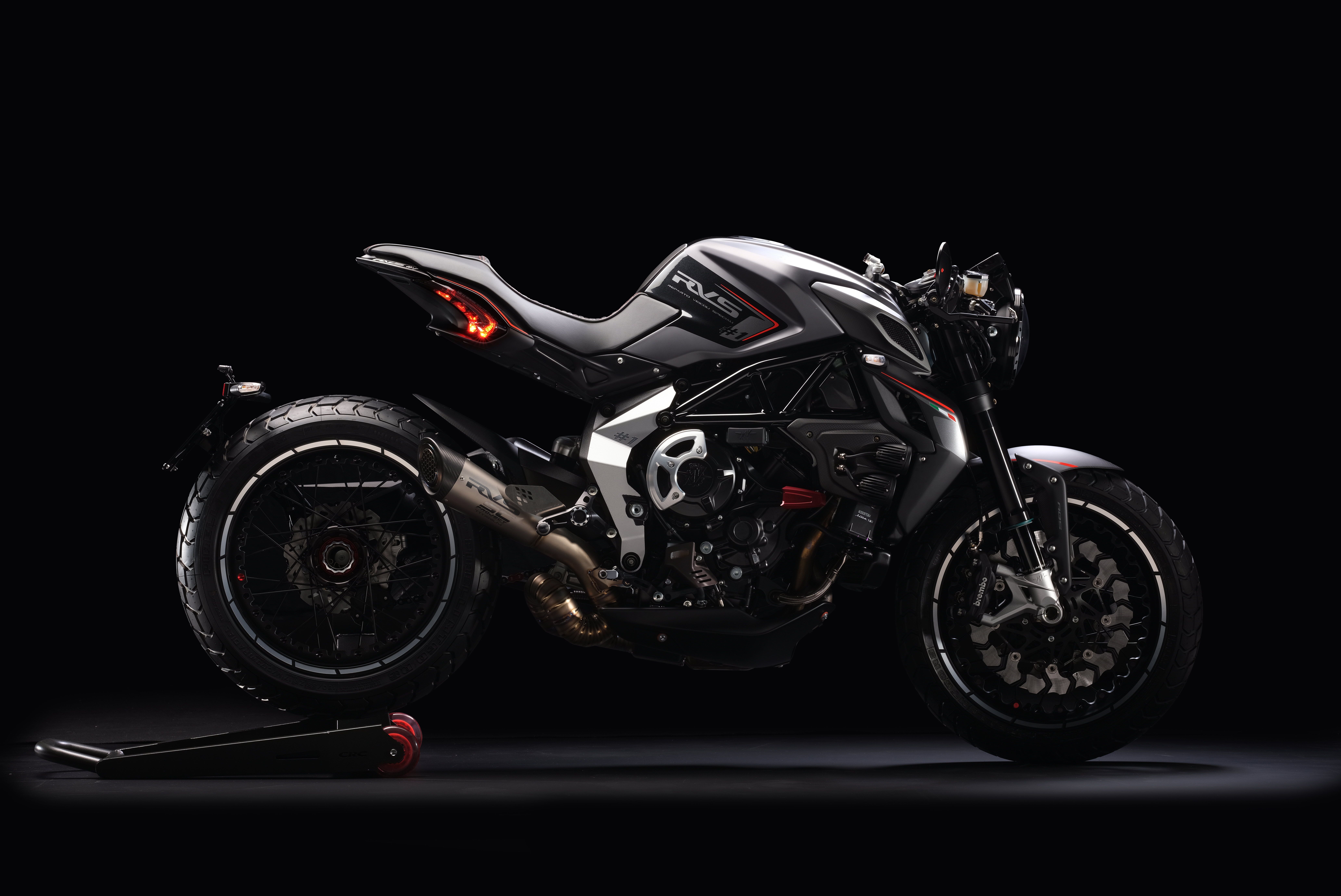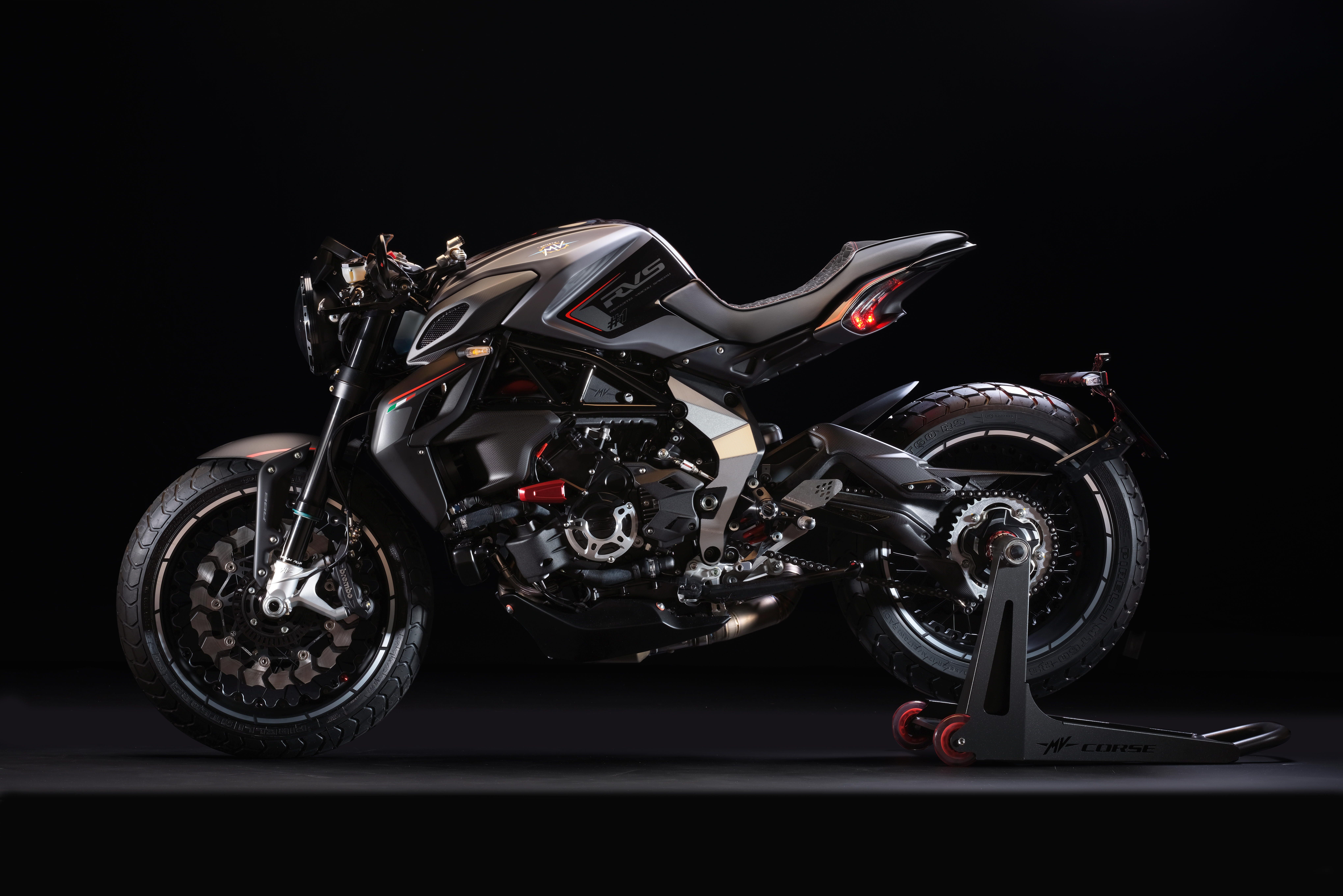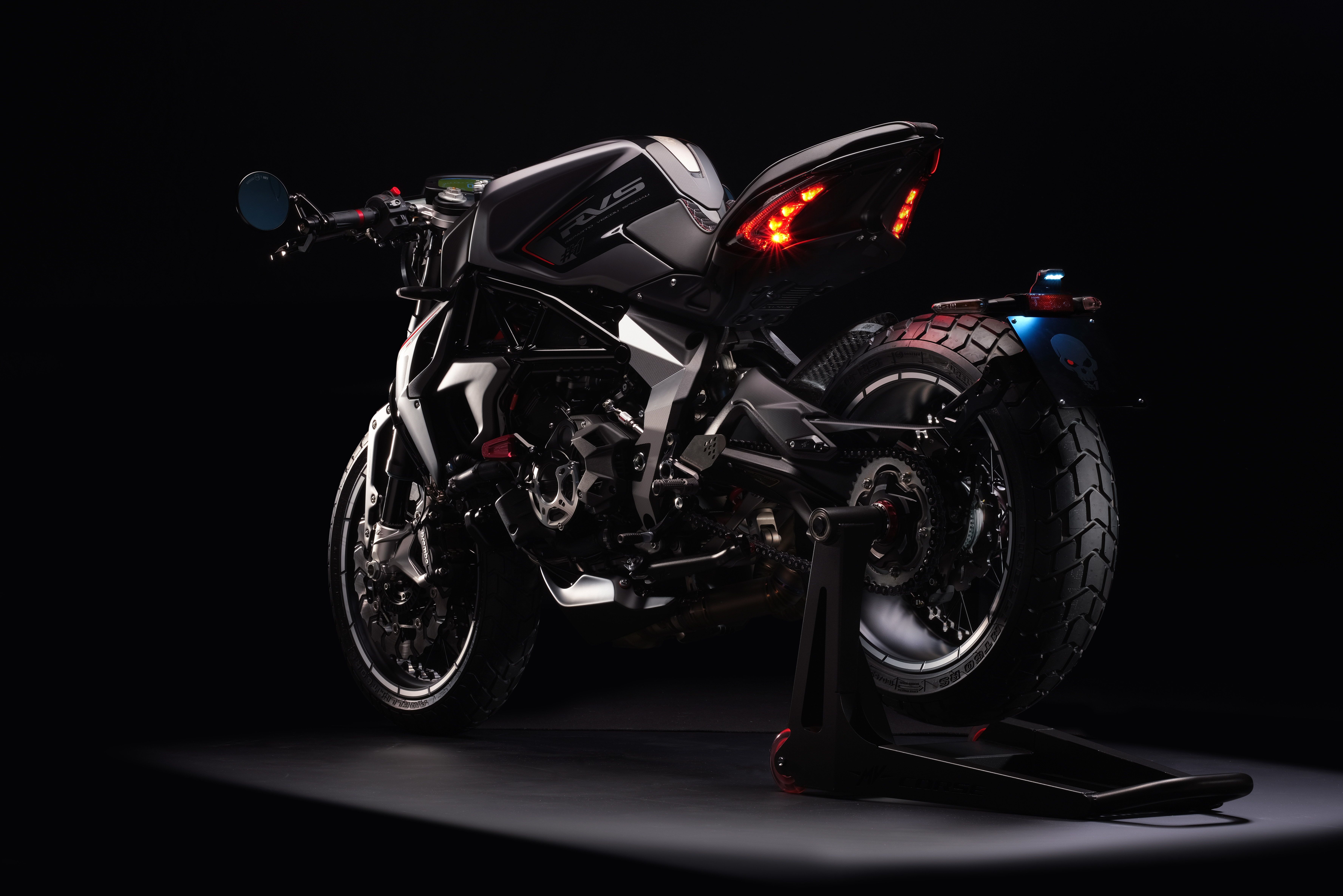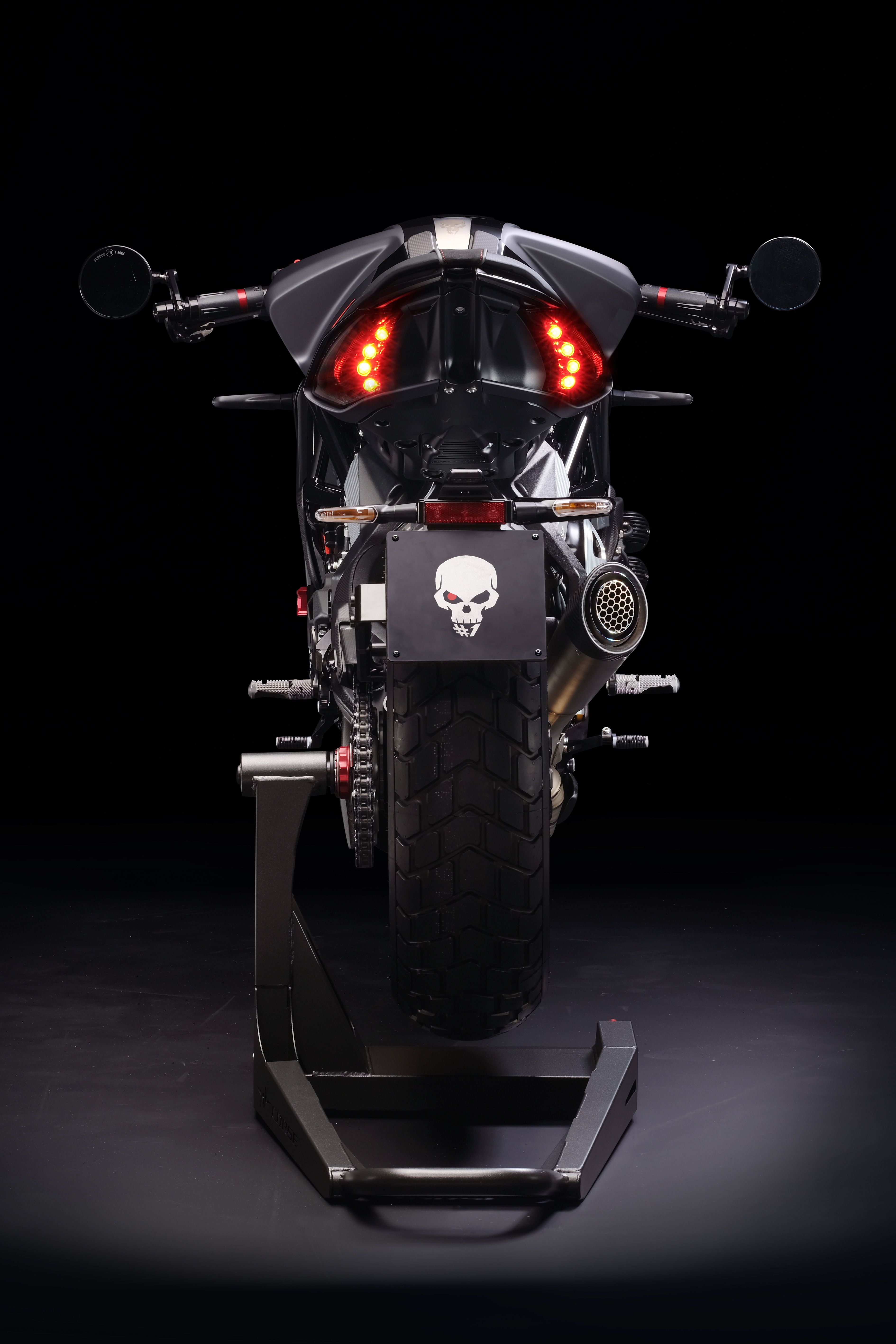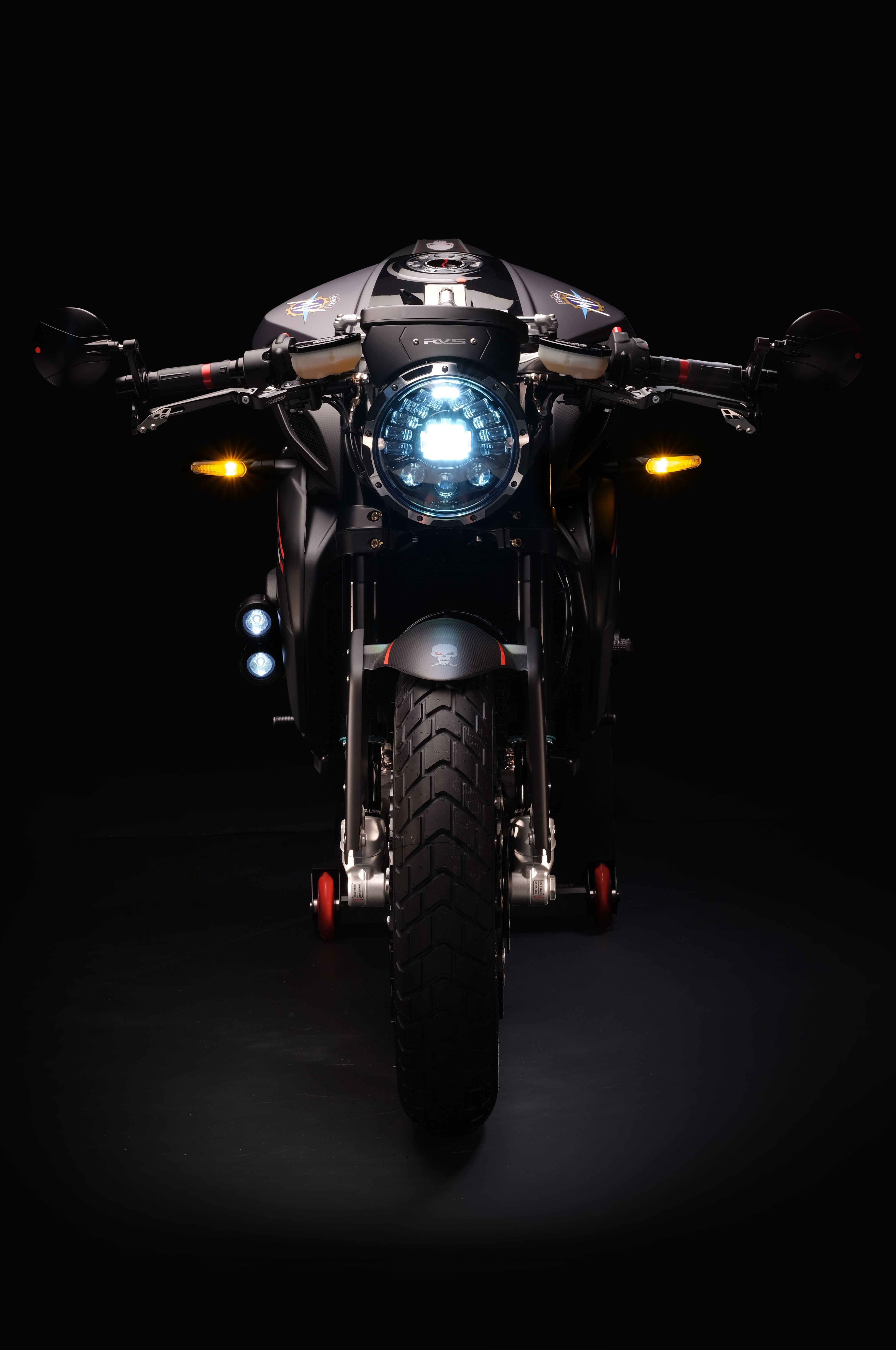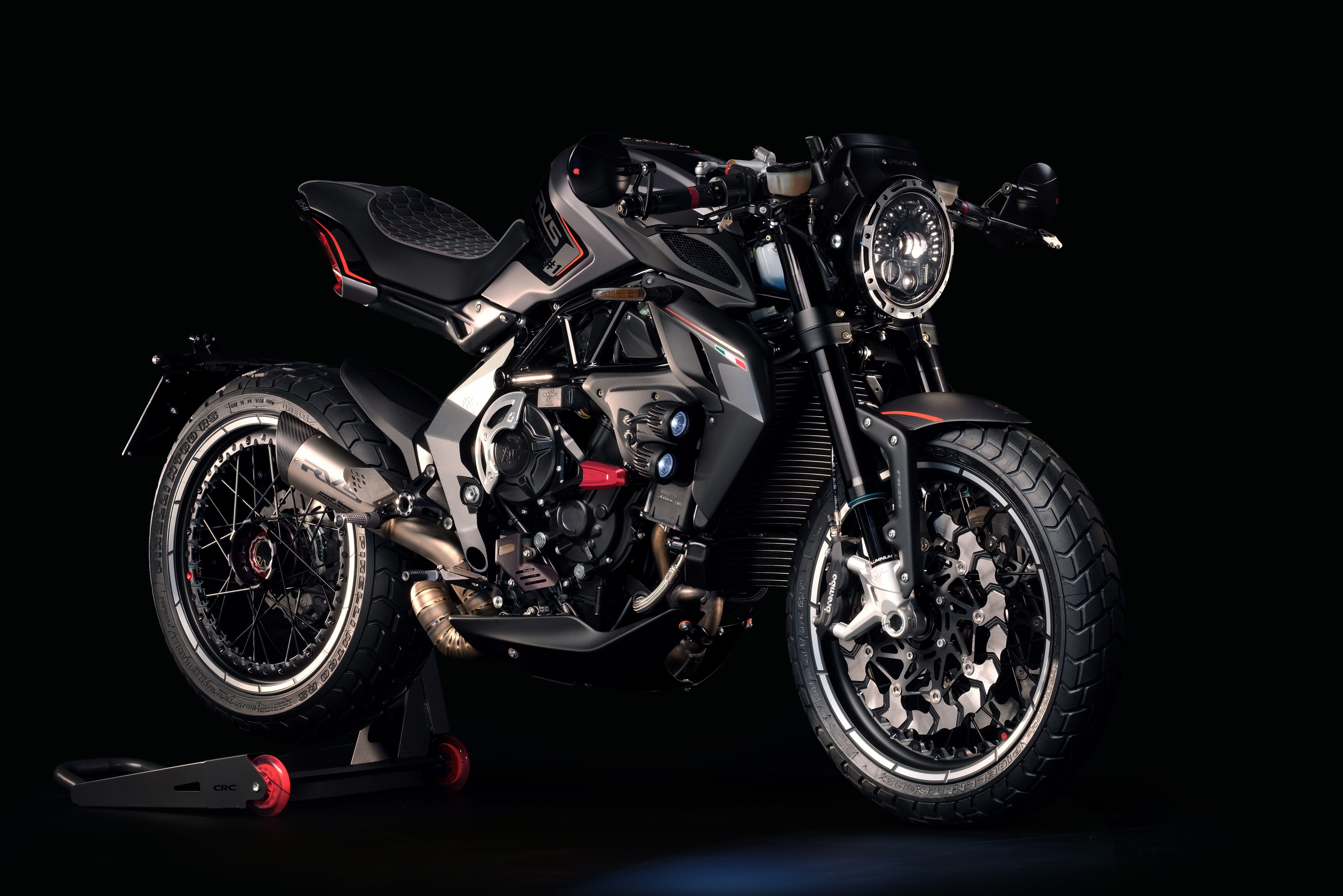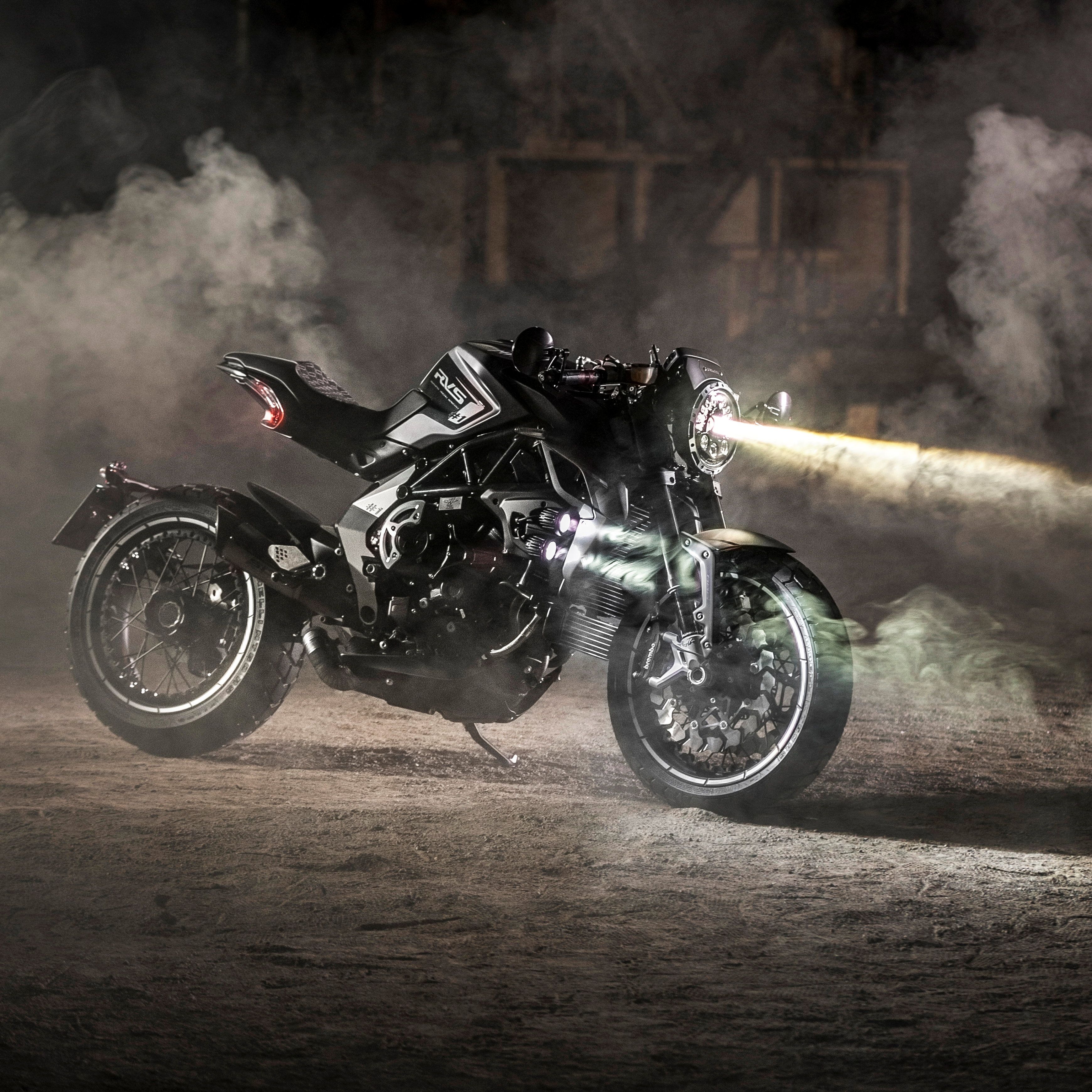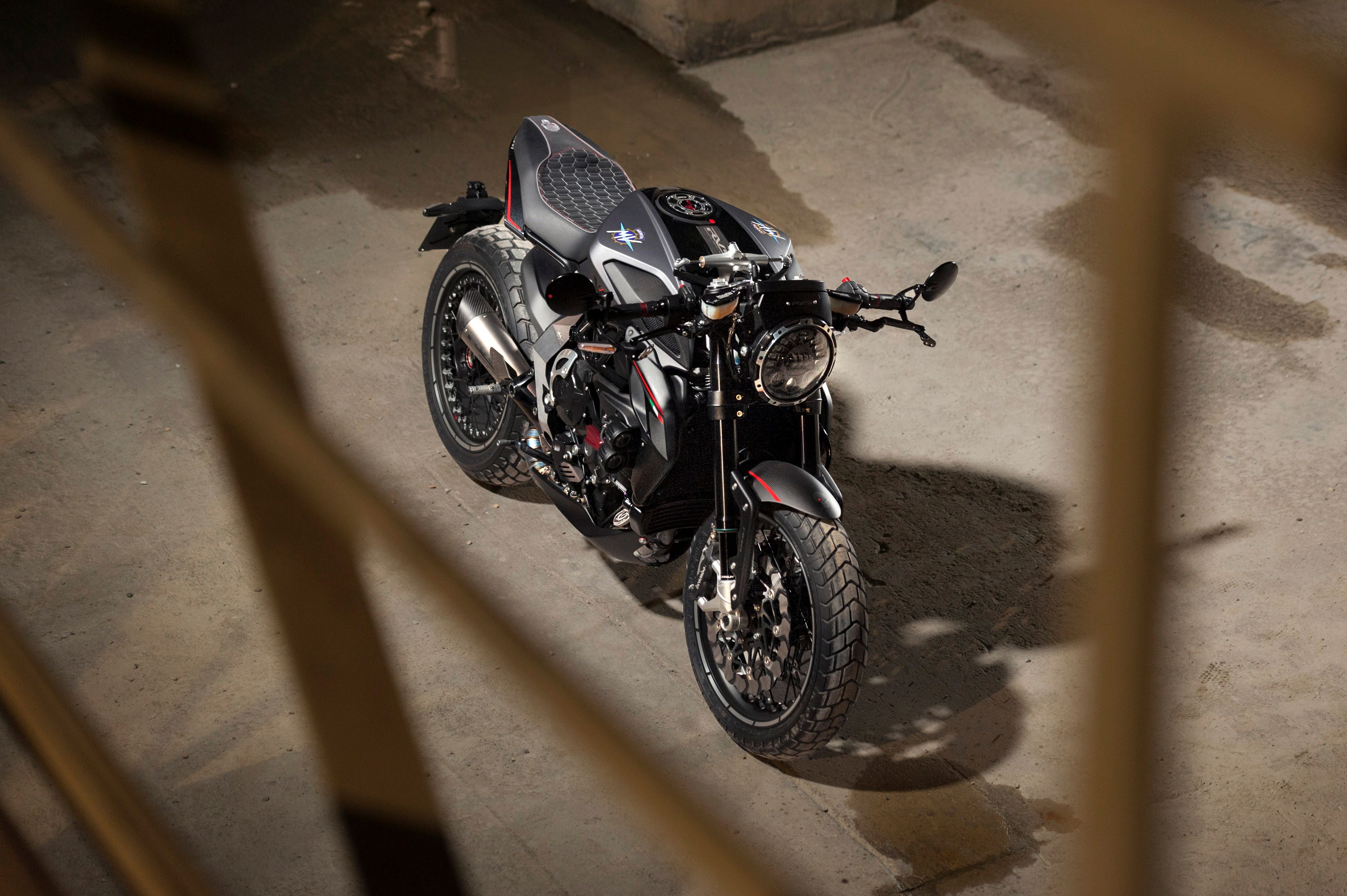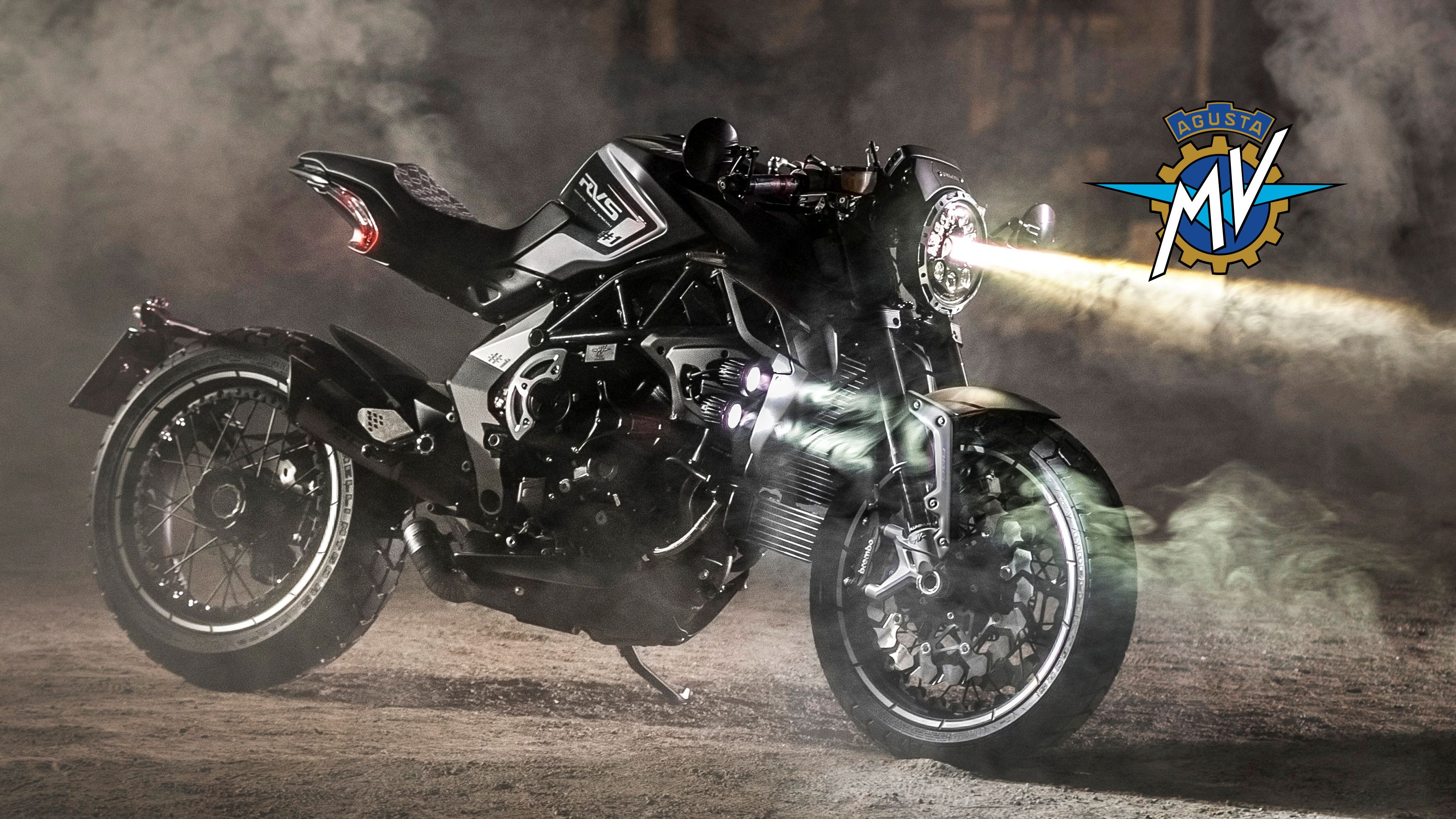2019 MV Agusta RVS #1
- Make: Array
- Model: 2019 MV Agusta RVS #1
- Engine/Motor: inline-3
- [do not use] Vehicle Model: Array
MV Agusta RVS #1 Design
The custom vibe comes on strong on the RVS#1 right off the bat in the front fender that is cut down to the limit of functionality, giving it a home-job vibe. Boomerang-shaped uprights mount to the fork feet and sport a foil-shaped cross-section that steers the incoming air around the fork tubes for a lowered resistance to penetration. Blackout treatment reinforces the custom vibe, especially since it covers even the inner fork tubes that are usually polished.
Both the front wheel and the brake rotors alternate polish and pitch for more of that home-built look, but it's the cast-alloy spokes and traditional laced construction that really sets the wheels off in spite of all that monochromatic treatment.
A round cyclops headlight housing carries a number of LED emitters, each with its own special aim, and here we find the first of the generous fandanglery. The inertial-measurement unit reads the lean angle and attitude of the chassis and illuminates the appropriate emitters to keep the light on the road where you need it, even in turns.
Short-standoff LED blinkers complete the forward lighting from their regretfully vulnerable mounts on the cowlings, but I tell you what I do like; the low-rise bar-end mirrors that contribute to that clean flyline and further the custom look. A single TFT screen handles the instrumentation and acts as the interface for the ride-control features.
The 4.36 gallon fuel tank rocks a strong flange up top that forms the top of the knee pocket along with the tapered section at the rear of the tank so you have room to tuck in or throw around some body English in the corners. A slightly upswept subframe comes with a low-profile pillion pad and fold-up footpegs so you can share the fun with a friend – if you have any who are brave enough. The rear swingarm cover, mudguard, and side fairings are all made from lightweight carbon fiber, and this is undoubtedly a contributing factor to the low, 370 pound dry weight.
MV Agusta RVS #1 Chassis
The tubular Trellis frame on the RVS#1 is built of tough ALS steel, but cast aluminum is the material of choice for the single-side swingarm and swingarm pivot plates to reduce both sprung and unsprung weight. A set of 17-inch rims mount Pirelli MT 60 RS WF hoops in a 120/70 up front opposite a 180/55 to round out the rolling chassis. The steering head comes stock with an adjustable damper to mitigate the kickback that can occur when the front end comes down from a moonshot. As for the steering geometry the trail is dead-short at only 3.74 inches long to make the RSV #1 as eager in the corners as it is coming off the line.
Inverted Marzocchi forks float the front end on 43 mm inner tubes and blackout struts, and here we find the first structural use of titanium at the top of the tripletree for the excellent strength-to-weight ratio it adds to the mix. Out back, a Sachs monoshock takes care of business with the same full trinity of adjustments as the forks as well as the same, 4.92-inch range of travel that should be plenty for even the roughest urban jungle.
Brembo supplies the four-pot calipers that bite the dual, 320 mm front discs and the twin-piston anchor that grabs the 220 mm disc out back. Anti-lock protection comes from the Bosch 9-Plus ABS feature that pulls double duty as a rear wheel lift-up preventer, keeping the rear wheel planted during heavy front-braking actions.
|
Fairing Material: |
Carbon fiber and thermoplastic |
|
Frame: |
ALS Steel tubular trellis |
|
Rear swing arm pivot plates material: |
Aluminum alloy |
|
Front Suspension: |
43 mm (1.69 in) Marzocchi “Upside Down” telescopic hydraulic fork in DLC treated aluminum, with anodized fork legs and having rebound-compression damping and spring preload external and separate adjustment |
|
Fork travel: |
4.92 in.(125 mm) |
|
Rear Suspension: |
Progressive Sachs, single shock absorber with rebound and compression damping and spring preload adjustment, Single sided swing arm material Aluminum alloy |
|
Wheel travel: |
4.92 in.(125 mm) |
|
Front brake: |
Double floating disc with Ø 320 mm (Ø 12.6 in.) diameter, with steel Braking Bat Fly disks, Brembo radial-type caliper with 4 pistons - Ø 32 mm (Ø 1.26 in.) |
|
Rear brake: |
Single Wave steel disc with Ø 220 mm (Ø 8.66 in.), Brembo caliper with 2 pistons - Ø 34 mm (Ø 1.34 in.) |
|
ABS System: |
Bosch 9 Plus with RLM (Rear wheel Lift-up Mitigation |
|
Front Wheel: |
Material/size With aluminum alloy spokes 3.50” x 17” |
|
Rear Wheel: |
Material/size With aluminum alloy spokes 6.00” x 17” |
|
Front Tire: |
Pirelli MT 60 RS WF 120/70 - ZR 17 M/C (58 W) |
|
Rear Tire: |
Pirelli MT 60 RS WR 180/55 - ZR 17 M/C (73 W) |
MV Agusta RVS #1 Drivetrain
As wild as the RVS #1 looks, it's still the understated blackout engine that steals the show. An inline triple, the liquid-cooled plant sports a 79 mm bore and 54.3 mm stroke for a total displacement of 798 cc and a smokin' hot 13.3-to-1 compression ratio. While that kind of compression will demand top-hook fuel or an octane booster, but that's the trade off if you want to unleash the full 140 horsepower at 12,500 rpm. With the addition of the SC Exhaust and ECM Racing map, you're looking at 150 shaft horsepower that tops out at 12,800 rpm. Torque measures at 64 pounds o' grunt at 10,100 rpm, so with figures like that, you know that the engine likes to get wound up and stay that way to remain in the useful power range.
Up front, separate water and oil coolers exchange waste heat with the atmosphere for all-around thermal protection of the bike's beating heart. A cassette-style, six-speed transmission crunches the ratios with a tough, chain-style final drive and an overall drive ratio that churns out a top speed of 153.1 mph with a zero-to-60 time of 3.72 seconds.
An electronic Shift Assist feature lets you work your way both up and down the range without ever touching the hydraulically-actuated clutch or rolling off the ride-by-wire throttle. The actual engine control falls to the Eldor EM2.0 system and Mikuni throttle bodies with influence from the higher engine electronics. A quartet of torque-control profiles and twice that many traction control profiles let you dial in power delivery to match your needs and taste. These work with the shift assist to turn in blistering holeshots and safe acceleration throughout the range, just what you want in a drag bike.
|
Engine: |
Three cylinder, 4 stroke, 12 valve, “D.O.H.C” with mechanical chain tensioner |
|
Displacement: |
798 cc (48.68 cu. in.) |
|
Compression ratio: |
13.3:1 |
|
Starting: |
Electric |
|
Bore x Stroke: |
79 mm x 54.3 mm (3.1 in. x 2.1 in.) |
|
Max. power (at the crankshaft): |
140 hp (103 kW) @ 12,500 rpm |
|
Max. torque : |
64 lb-ft (87 Nm) @ 10,100 rpm |
|
Cooling system: |
Cooling with separate liquid and oil radiators |
|
Engine management system: |
Integrated ignition - injection system MVICS 2.0 (Motor & Vehicle Integrated Control System) with six injectors. Engine control unit, Eldor EM2.0, throttle body full ride by wire Mikuni, pencil-coil with ion-sensing technology, control of detonation and misfire, Torque control with four maps, Traction Control with eight levels of intervention |
|
Electronic quick-shift: |
MV EAS 2.0 (Electronically Assisted Shift up & down) |
|
Clutch: |
Multi-disk wet clutch with hydraulic actuation |
|
Transmission: |
Cassette style; six speed, constant mesh |
|
Primary drive: |
22/41 |
|
Gear ratio: |
First gear: 13/37, Second gear: 16/34, Third gear: 18/32, Fourth gear: 19/30, Fifth gear: 21/30, Sixth gear: 22/29 |
|
Final drive ratio: |
16/41 |
MV Agusta RVS #1 Pricing
A current U.S. price was hard to find, but I feel comfortable estimating it to be in the $40k range on our side of the pond. MV Agusta offers this beauty in two-tone Metal Carbon Black / Metal Anthracite.
MV Agusta RVS #1 Competitors
With such a drag-tastic machine to compete against, it was difficult to find an exact matchup for the RVS#1. Instead I grabbed a couple of bikes that I think will appeal to the same sort of rider. Since form follows function on these machines, I'll limit my commentary to their capabilities.
Kawasaki Z H2
First up is the Z H2 from Kawasaki, the supercharged bad boy that packs a liter-size four banger and a half-naked build. The numbers from the engine are impressive; it puts out 197 horsepower at 11,000 rpm and 99 pound-feet of torque at 10,500 rpm for a 0-to-60 time of 3.1 seconds. Yep, that's quicker than the Italian's 3.72-second run, and it comes at much less expense with a $17k sticker that's mighty tempting in light of the projected, luxury-level, $40k price tag. Launch control, traction control and a quickshifter come stock on the Kawi, so that leaves the RSV #1 without a single clear advantage and several disadvantages.
Read our full review of the Kawasaki Z H2.
Suzuki Hayabusa
Next up is another drag-tastic machine, the Hayabusa from Suzuki. Long positioned at the top of the foodchain, the stretched-out 'Busa can get from 0-to-60 in only 2.6 seconds to leave both of the above sucking hind tit.
No doubt the Hayabusa is the King of the Streets, and is the bike to beat on a straight quarter-mile run, but the trade off is in the corners. Namely that the RVS #1 and Z H2 are both set up for better cornering and have more top-drawer electronics to help you keep them under control. The $14,799 sticker looks pretty good, but if you consider what you trade in safety systems, it may not be worth it, especially if your skillset is a bit lacking.
Read our full review of the Suzuki Hayabusa.
He Said
“MV Agusta calls what they do “motorcycle art,” and I am inclined to agree. Only the rarest bikes would draw the eye more than this rolling art, and even if it ain't your cup o' tea, you've got to appreciate the passion MVA's design team brings to the table. In light of the competition from Japan, I'm inclined to say that this bike will appeal to more of a collector-type buyer than your average, everyday rider.”
She Said
My wife and fellow motorcycle writer, Allyn Hinton, says, “What an extraordinary bike. When first asked to look at it, I was like, 'Oh yeah, it's an awesome-looking bike,' but the closer I looked, the more I saw how exquisite it really is. Nothing is left to chance, and nothing is overlooked. The adaptive headlight is a marvel. The IMU controls the LEDs to create dynamic lighting according to the orientation of the bike. Take a look at the close-up of the headlight. It's technology like this that excites me as a mechanic and an electronics technician.”
MV Agusta RVS #1 Specifications
|
Engine & Drivetrain: |
|
|
Engine: |
Three cylinder, 4 stroke, 12 valve, “D.O.H.C” with mechanical chain tensioner |
|
Displacement: |
798 cc (48.68 cu. in.) |
|
Compression ratio: |
13.3:1 |
|
Starting: |
Electric |
|
Bore x Stroke: |
79 mm x 54.3 mm (3.1 in. x 2.1 in.) |
|
Max. power (at the crankshaft): |
140 hp (103 kW) @ 12,500 rpm |
|
Max. torque : |
64 lb-ft (87 Nm) @ 10,100 rpm |
|
Cooling system: |
Cooling with separate liquid and oil radiators |
|
Engine management system: |
Integrated ignition - injection system MVICS 2.0 (Motor & Vehicle Integrated Control System) with six injectors. Engine control unit, Eldor EM2.0, throttle body full ride by wire Mikuni, pencil-coil with ion-sensing technology, control of detonation and misfire, Torque control with four maps, Traction Control with eight levels of intervention |
|
Electronic quick-shift: |
MV EAS 2.0 (Electronically Assisted Shift up & down) |
|
Clutch: |
Multi-disk wet clutch with hydraulic actuation |
|
Transmission: |
Cassette style; six speed, constant mesh |
|
Primary drive: |
22/41 |
|
Gear ratio: |
First gear: 13/37, Second gear: 16/34, Third gear: 18/32, Fourth gear: 19/30, Fifth gear: 21/30, Sixth gear: 22/29 |
|
Final drive ratio: |
16/41 |
|
Chassis: |
|
|
Fairing Material: |
Carbon fiber and thermoplastic |
|
Frame: |
ALS Steel tubular trellis |
|
Rear swing arm pivot plates material: |
Aluminum alloy |
|
Front Suspension: |
43 mm (1.69 in) Marzocchi “Upside Down” telescopic hydraulic fork in DLC treated aluminum, with anodized fork legs and having rebound-compression damping and spring preload external and separate adjustment |
|
Fork travel: |
4.92 in.(125 mm) |
|
Rear Suspension: |
Progressive Sachs, single shock absorber with rebound and compression damping and spring preload adjustment, Single sided swing arm material Aluminum alloy |
|
Wheel travel: |
4.92 in.(125 mm) |
|
Front brake: |
Double floating disc with Ø 320 mm (Ø 12.6 in.) diameter, with steel Braking Bat Fly disks, Brembo radial-type caliper with 4 pistons - Ø 32 mm (Ø 1.26 in.) |
|
Rear brake: |
Single Wave steel disc with Ø 220 mm (Ø 8.66 in.), Brembo caliper with 2 pistons - Ø 34 mm (Ø 1.34 in.) |
|
ABS System: |
Bosch 9 Plus with RLM (Rear wheel Lift-up Mitigation |
|
Front Wheel: |
Material/size With aluminum alloy spokes 3.50” x 17” |
|
Rear Wheel: |
Material/size With aluminum alloy spokes 6.00” x 17” |
|
Front Tire: |
Pirelli MT 60 RS WF 120/70 - ZR 17 M/C (58 W) |
|
Rear Tire: |
Pirelli MT 60 RS WR 180/55 - ZR 17 M/C (73 W) |
|
Dimensions & Capacities: |
|
|
Wheelbase: |
54.33 in.(1,380 mm) |
|
Overall length: |
79.72 in.(2,025 mm) |
|
Overall width: |
31.89 in.(810 mm) |
|
Saddle height: |
31.30 in.(795 mm) |
|
Min. ground clearance: |
5.87 in.(149 mm) |
|
Trail: |
3.74 in.(95 mm) |
|
Dry weight: |
370.4 lbs.(168 kg) |
|
Fuel tank capacity: |
4.36 U.S. gal.(16.5 l) |
|
Fuel economy: |
34 mpg (6.8 l/100 km) |
|
Maximum speed: |
153.1 mph (245.0 km/h) |
|
Electrical: |
|
|
Voltage: |
12 V |
|
Alternator: |
350 W @ 5,000 rpm. |
|
Battery: |
12 V - 8.6 Ah |
Further Reading
MV Agusta
Read more MV Agusta news.

